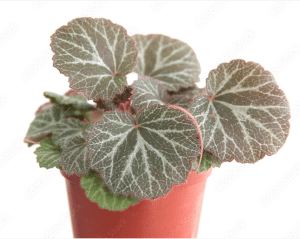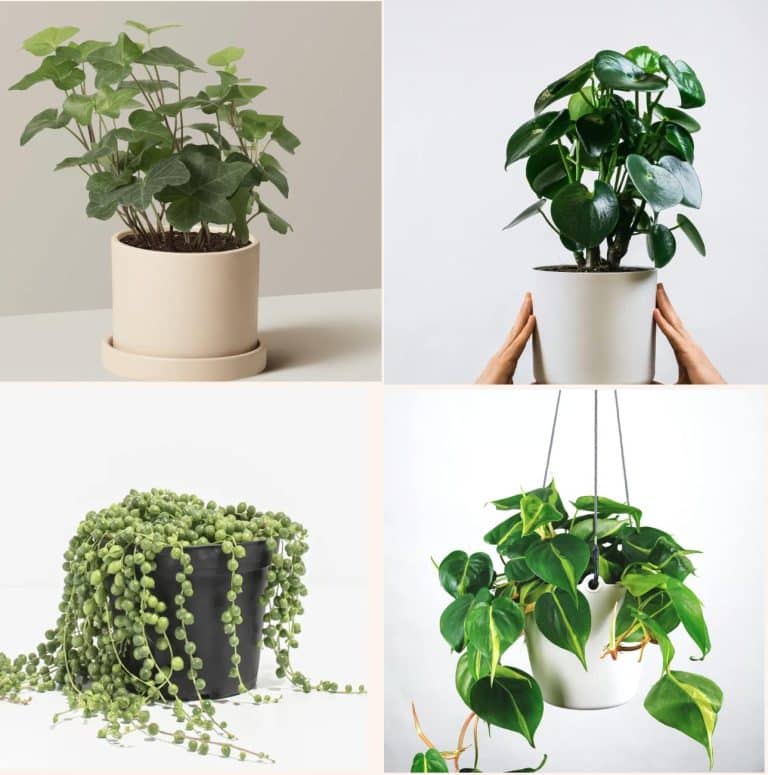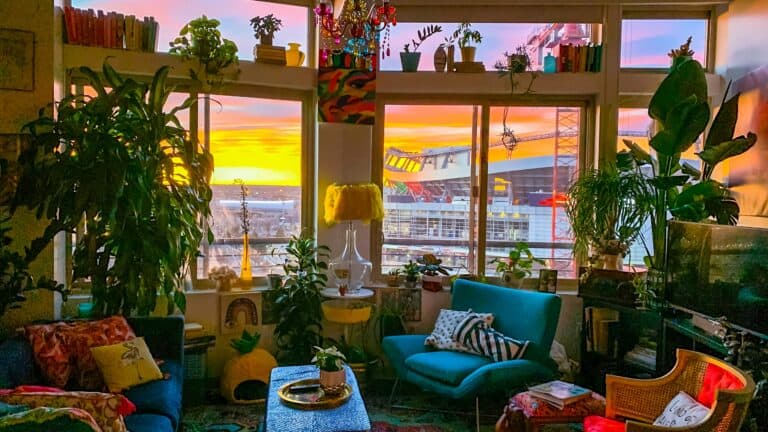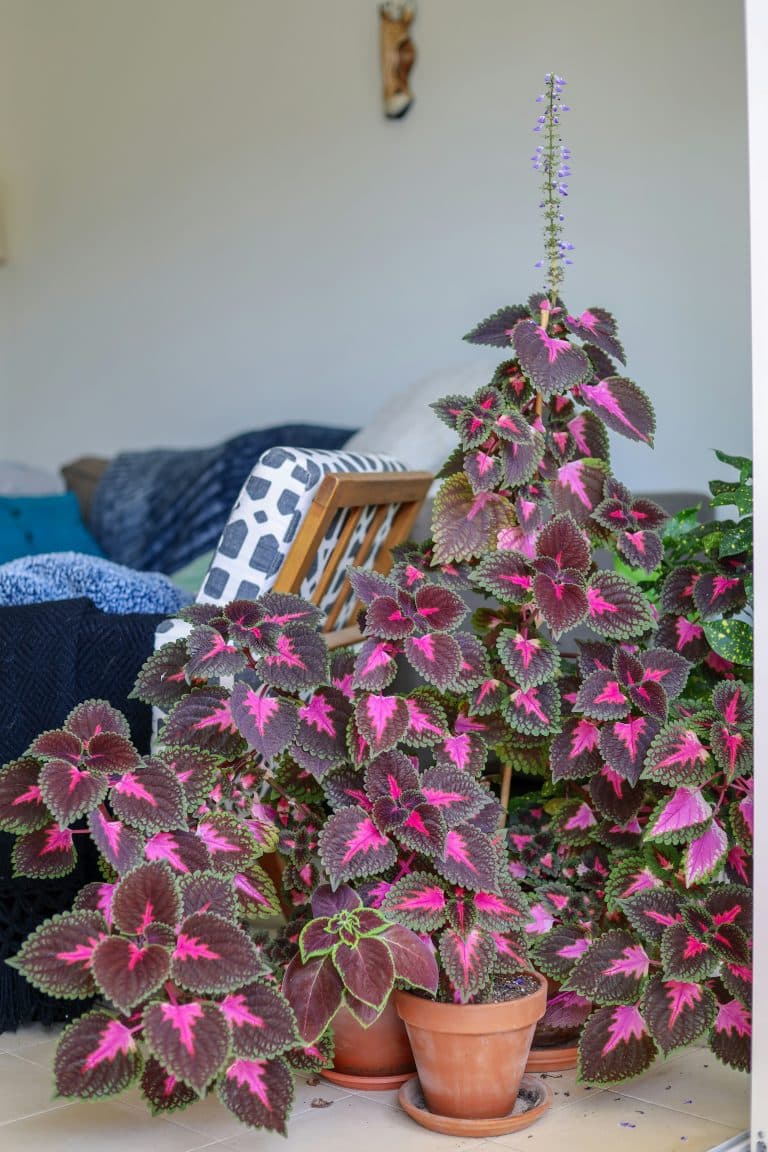Ultimate guide to 50 indoor plants not toxic to cats and dogs
Look no further—this ultimate collection of 50 pet-safe houseplants lets you green your space without putting your furry friends at risk. All non-toxic, all beautiful.
When you purchase through links on our site, we may earn an affiliate commission, which helps sustain our blog!
Houseplants are meant to provide you with peace, love and serenity, not anxiety. Especially if you have cats or dogs in your space and you’re afraid what harm eating plants may cause to them. Read our handy cat toxicity chart that tells you what to do when you cat eats a plant by mistake!
According to a study by the American Society for the Prevention of Cruelty to Animals, many common houseplants can be toxic to pets, causing everything from mild irritation to severe health issues.
Over the years of living in our Brooklyn community home, with our quirky mix of two cats and thriving trailing plants and tall trees, we’ve navigated the delicate balance of creating a pet-safe indoor garden.
In this article, we’ll guide you through:
Let’s dive in.
Summary:
- What are the best houseplants safe for cats and dogs?
- Hoya plant, Parlor palm, Olive tree, Spider Plant, Calathea Plant, Peperomia, Bromeliad, Orchids, and Money Tree. These are a mix of small and large plants that are relatively easy to care for.
Snapshot of our Top 5 picks
1. Hoya plant

2. Parlor palm
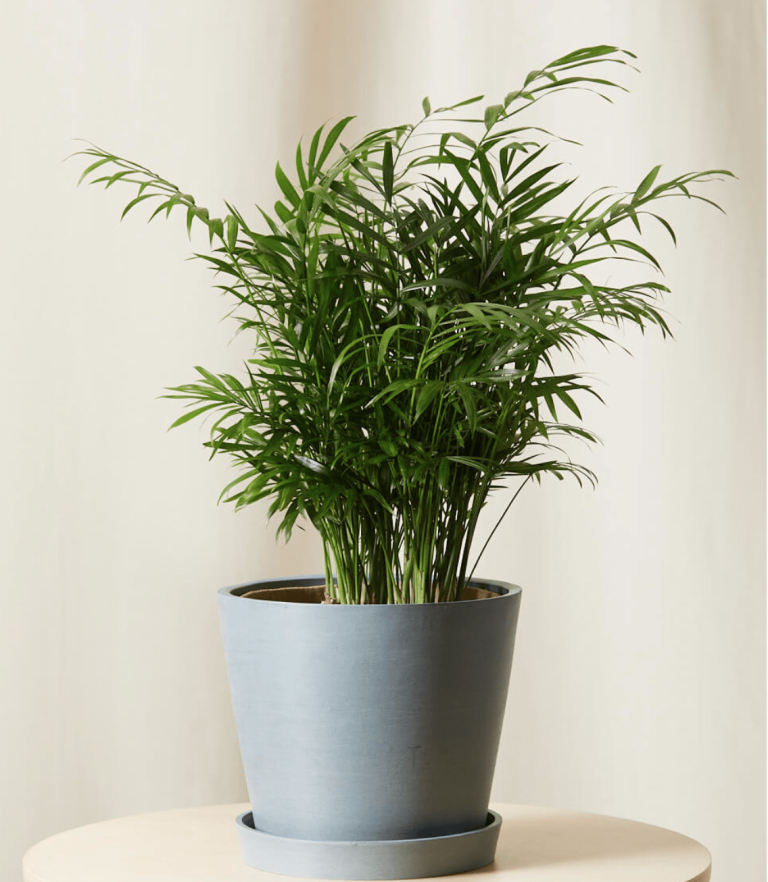
3. olive tree
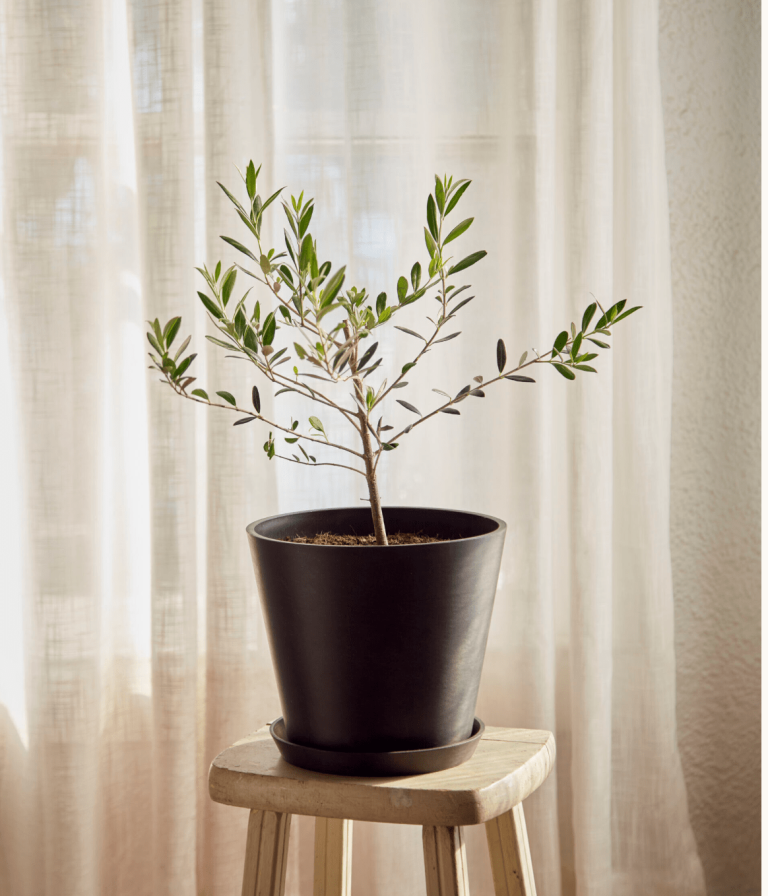
4. Spider plant
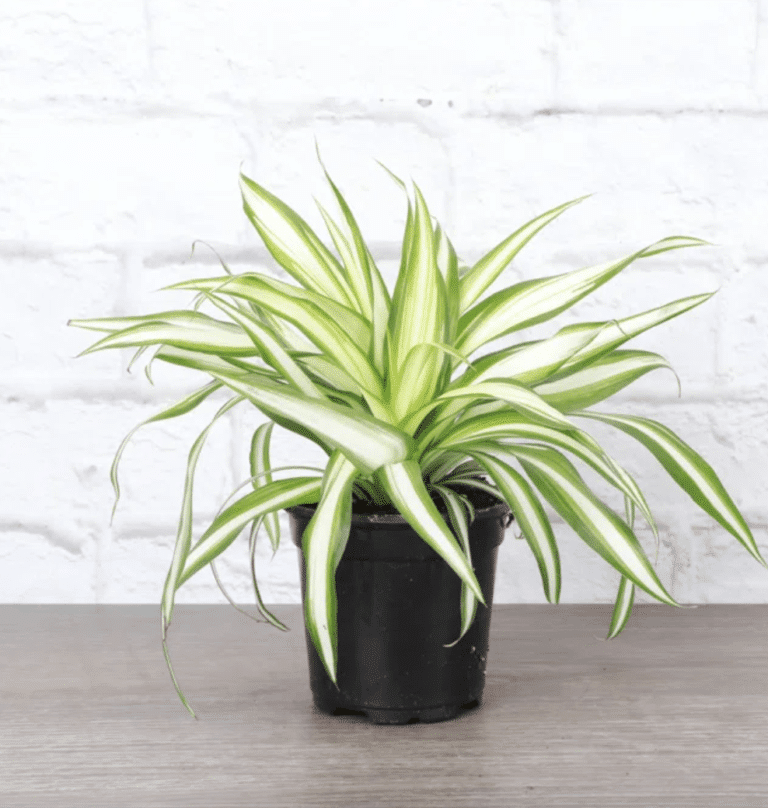
5. Calathea Plant
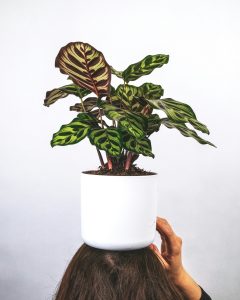
Here are our 50 indoor plants not toxic to cats and dogs
1. Boston fern
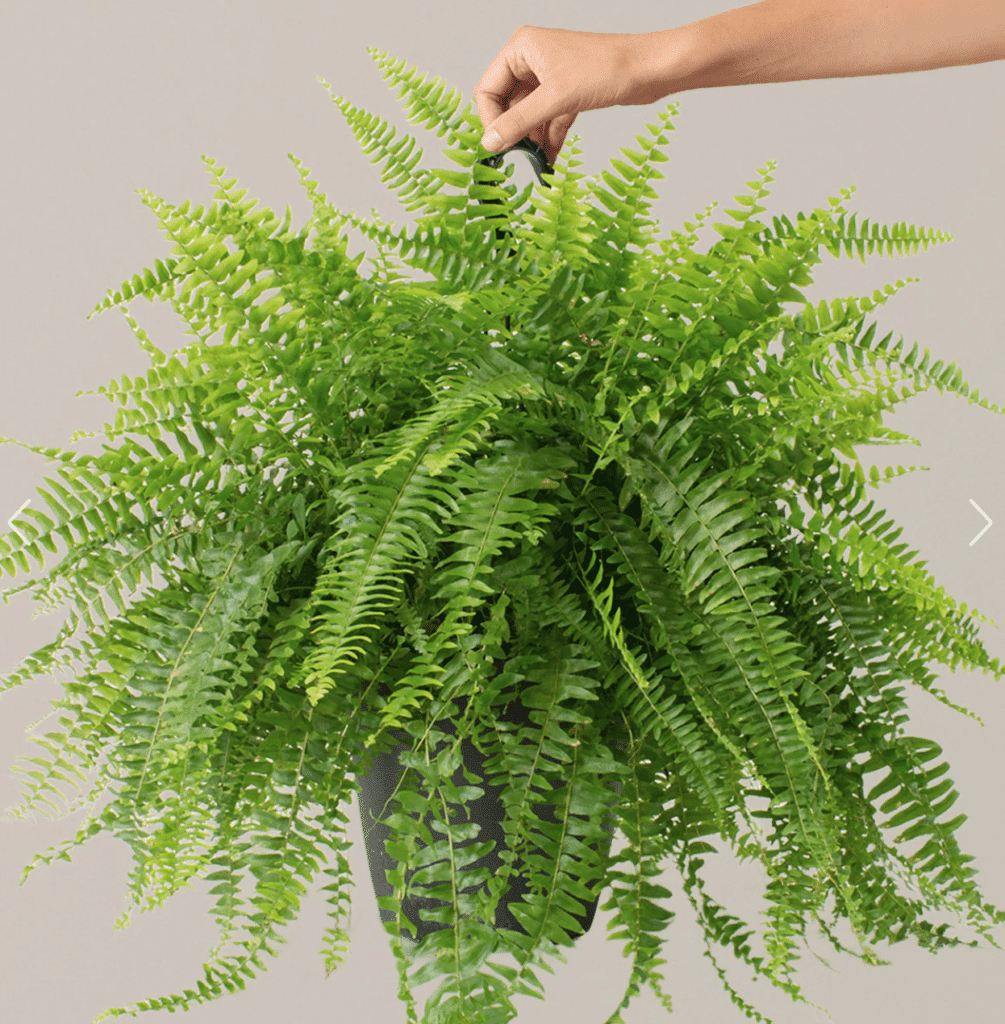
Pet safe
Low light
Grows upto 3 feet
North facing windows
Pet safe
low light
grows to 3 feet
North facing windows
The Boston Fern (aka Nephrolepis exaltata): part of the Nephrolepidaceae family, this plant has lush, arching fronds with feather-like leaflets. We have placed ours in one of our North-facing room. This one thrive in low to medium light and prefer high humidity – so a bit more demanding, but worth it for their aesthetic appeal. These could also work great in bathroom as hanging plants!
This indoor plant is not toxic to cats and dogs, and their vibrant green foliage can grow up to 2-3 feet long. Keep the soil consistently moist and mist regularly to maintain its lush appearance. We recommend styling them in hanging baskets.
Care tip:
- Place it in indirect light and keep the soil consistently moist, watering when the top inch feels dry.
- Mist regularly to maintain high humidity.
- When fronds turning yellow, it indicates low humidity or under-watering.
Propagation tip:
- Divide a healthy plant into sections which has fronds and roots.
- Plant them in well-draining potting soil.
- Keep the soil moist and place in bright, indirect light. Roots should establish in 4-6 weeks.
Symbolism and zodiac signs:
- Symbolizes sincerity and shelter. Ideal for Pisces known for their nurturing and empathetic nature
Pros and cons
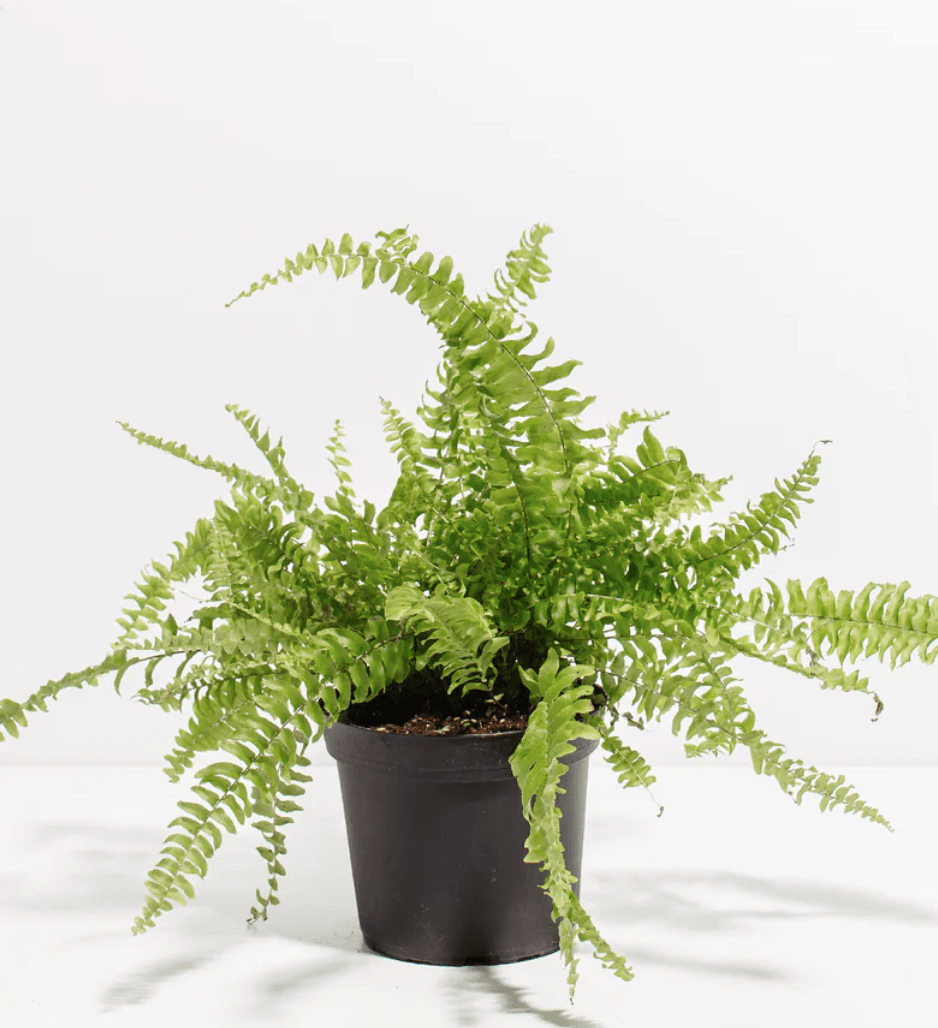
($58)

($50)
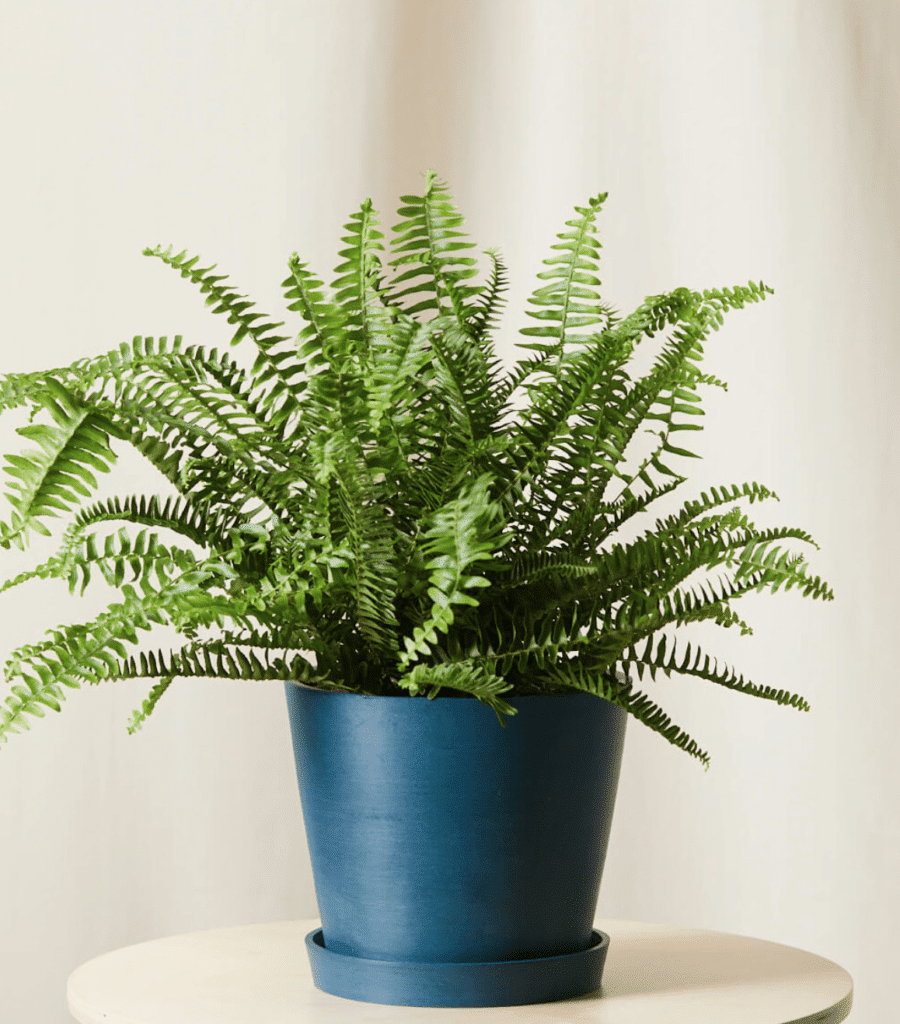
($31)
$24
“Beautiful, lush plant that adds a lot of greenery to my home. Needs regular watering”
2. Spider plant
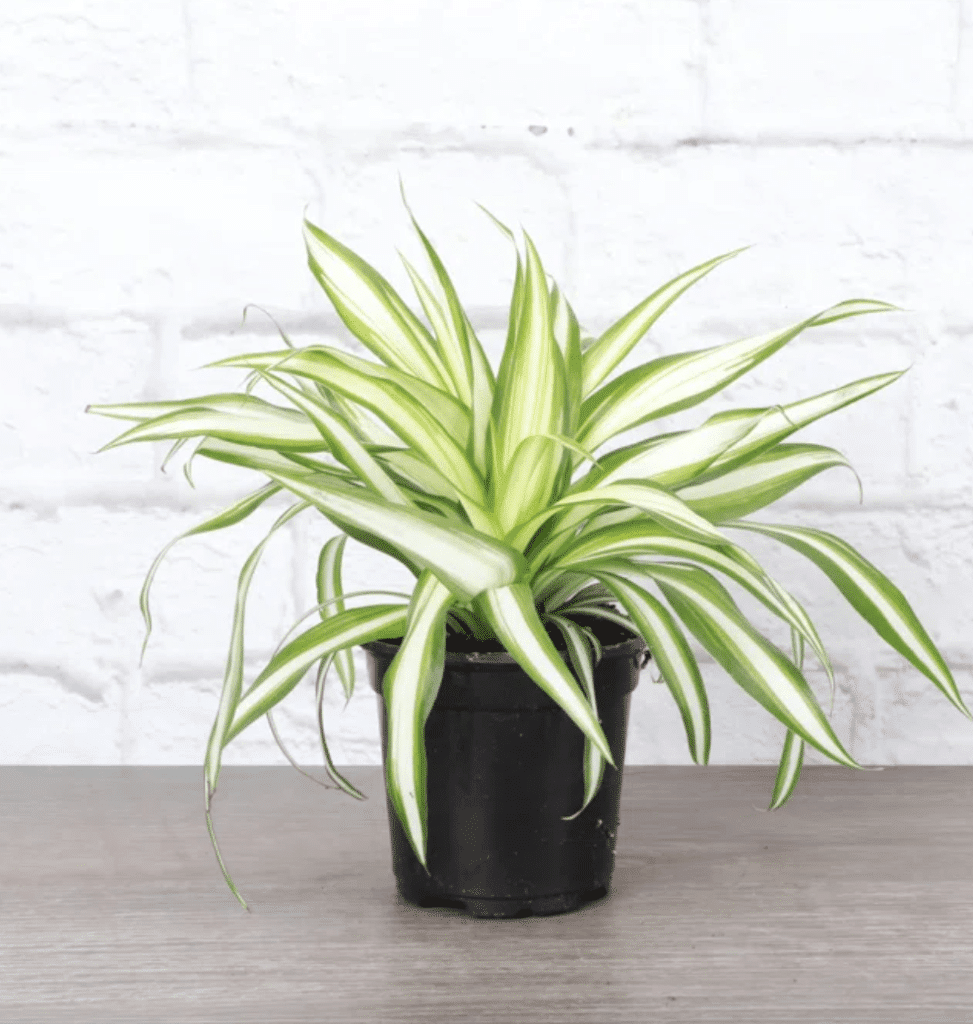
Pet safe
Low/medium light
Grows upto 3 feet
East/west windows
Pet safe
low light
grows to 3 feet
East/west facing windows
The Spider Plant (aka Chlorophytum comosum): This plant is a member of the Asparagaceae family. It is super slender, has arching leaves, and boasts a bursting green with a distinctive creamy white stripe running down the center. This one doesn’t just sit pretty—its cascading foliage can look stunning in hanging baskets or even in high shelves where you don’t get much sunlight. We have placed our Spider Plant in the east-facing reading room, where it benefits from a lot of indirect light.
Occasionally, the Spider Plant produces small white flowers and spawns mini “spiderettes” that can be propagated easily. At its full length it comes upto about 2 feet which is a great balance between small and large floor plants. Personally, we’ve styled it in a maroon ceramic pot that complements both the plant and the decor of our rustic reading room
Care tip:
- Water weekly, allowing the top inch of soil to dry out between waterings.
- Place in bright, indirect light and avoid direct sunlight to prevent leaf scorch.
- Browning leaf tips can indicate fluoride sensitivity – try using distilled or rainwater.
Propagation tip:
- Place a spiderette in a glass jar filled with room temperature distilled water. Only roots are submerged, not the leaves.
- Place the jar in bright, indirect light and change the water every week or so to prevent stagnation.
- Roots should start to appear within a week or two. Once they are 2-3 inches long, transfer to soil.
Symbolism and zodiac signs:
- The Spider Plant symbolizes abundance, and purity, and good luck because of its prolific nature in producing offshoots. Perfectly suited for Virgo’s who are known for their attention to health and cleanliness, and are most apt to care for this plant.
Pros and cons
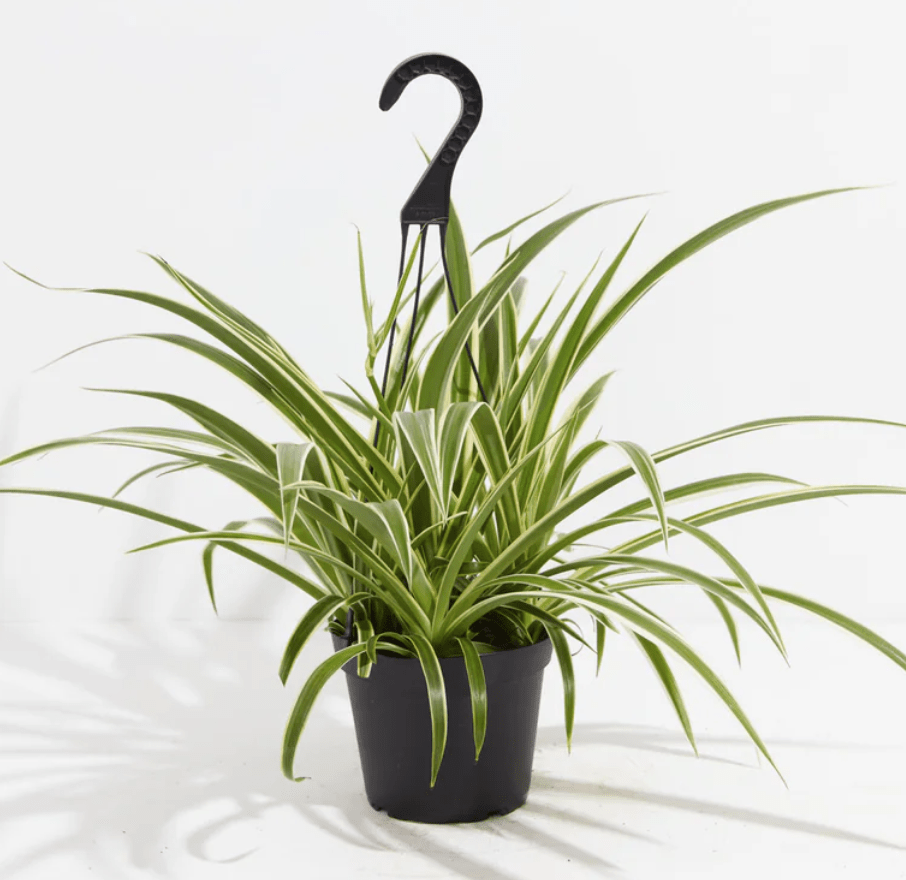
($43)
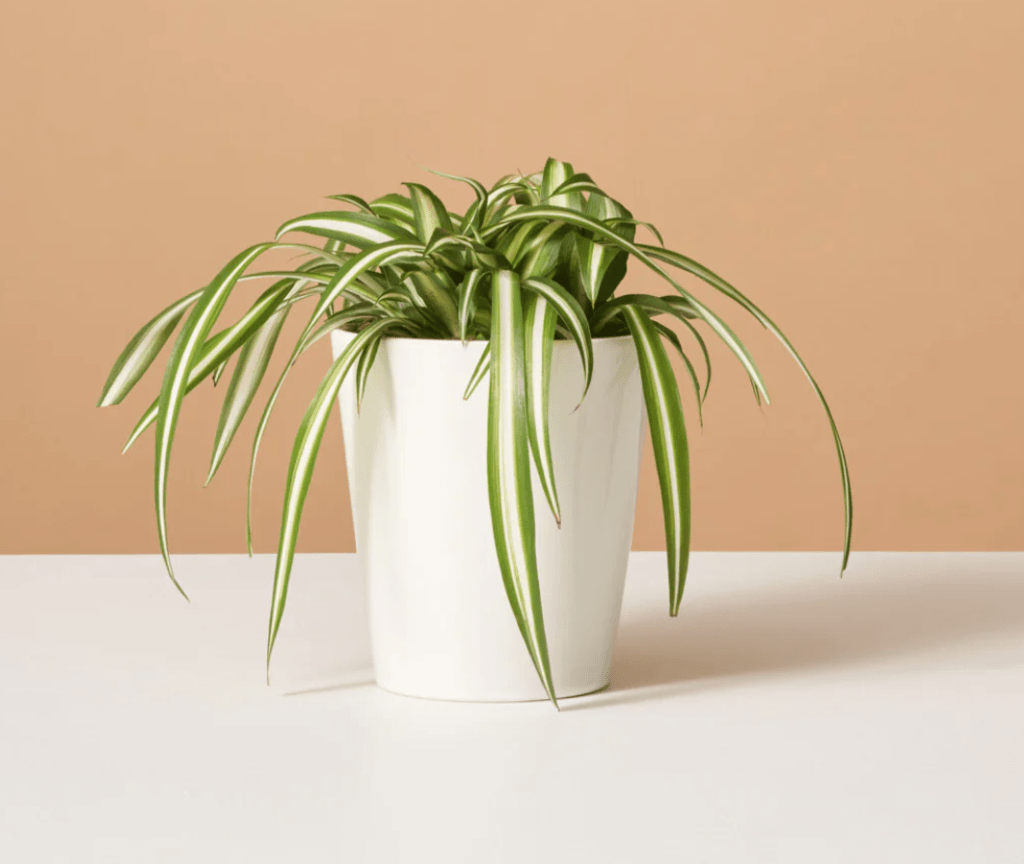
($69)

($37)
$15
“This plant is very forgiving and easy to propagate. Great for plant beginners”
3. Areca palm
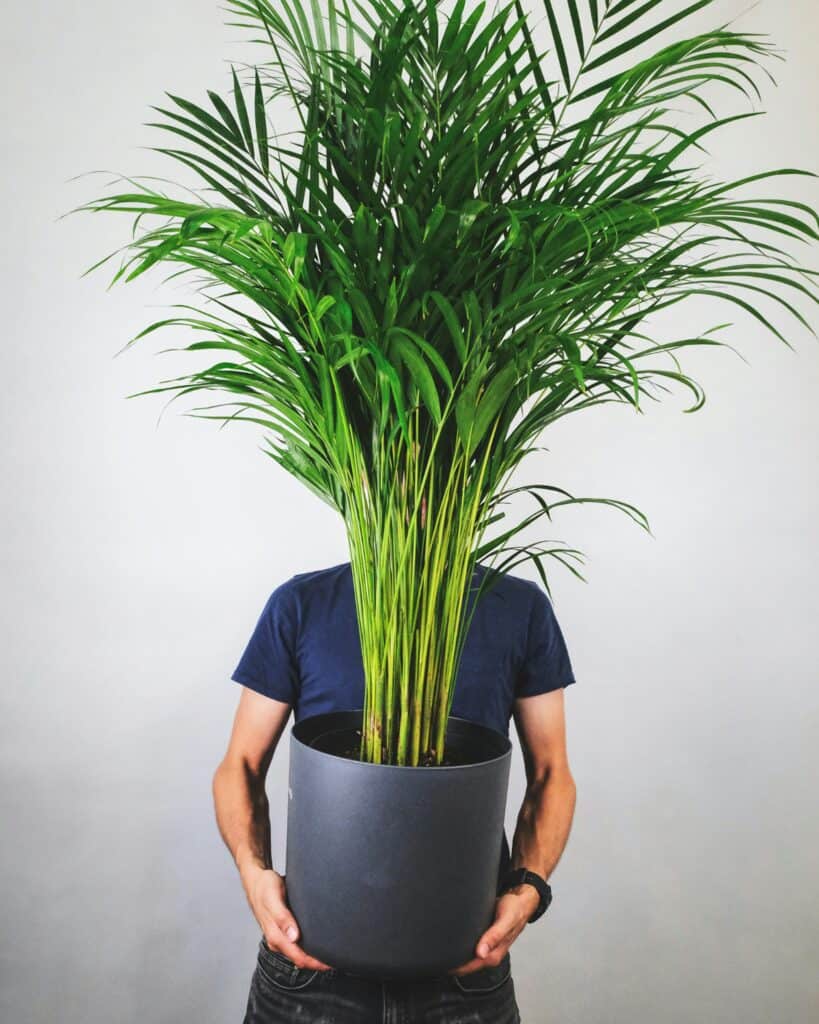
Pet safe
Low/medium light
Grows upto 10 feet
East/west facing windows
Pet safe
low light
grows to 10 feet
East/west facing windows
The Areca Palm (aka Dypsis lutescens): This plant part of the Arecaceae family, has arching fronds that are a striking feature of plants from the tropical climates. Their lush, light green leaves bring a soft, airy feel to your space. We’ve placed our Areca Palm in the west-facing living room on the first floor where the bright, indirect light bathes its fronds, and where our furry animals roam around as this indoor plant is not toxic to cats and dogs.
At the moment, it is styled in a large, white ceramic planter to go with its lush fronds. When it matures, this palm can reach up to 6-7 feet, making a bold and dramatic vertical statement.
Care tip:
- Thrives in bright, indirect light. Water it when the top inch of soil feels dry — usually every 1-2 weeks.
- Drooping leaves signal overwatering or insufficient light. Consider misting it occasionally or placing a humidifier nearby to mimic its tropical origins.
Propagation tip:
- Separate one of the offshoots with its own roots and plant into potting soil. Water regularly to keep the soil moist, and place it in bright, indirect light. Root development for the new plant can take several weeks, unfortunately.
Symbolism and zodiac signs:
- The Areca Palm symbolizes peace and prosperity – apt for Libra’s appreciation for harmony and beauty in their environment.
Pros and cons
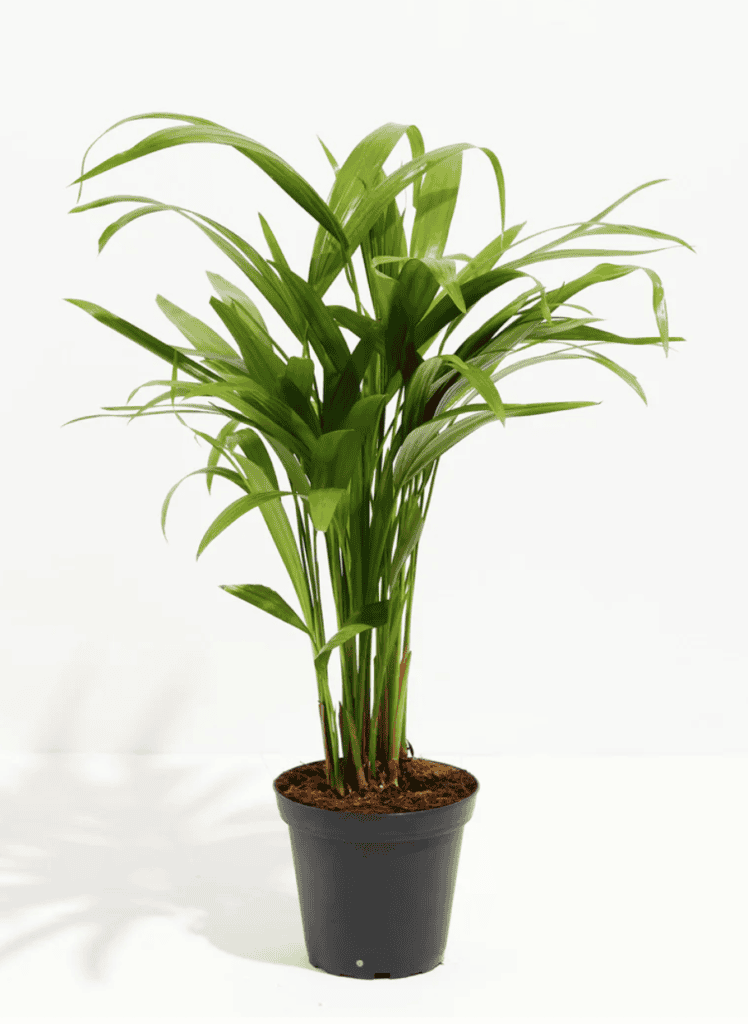
($43)

($98)
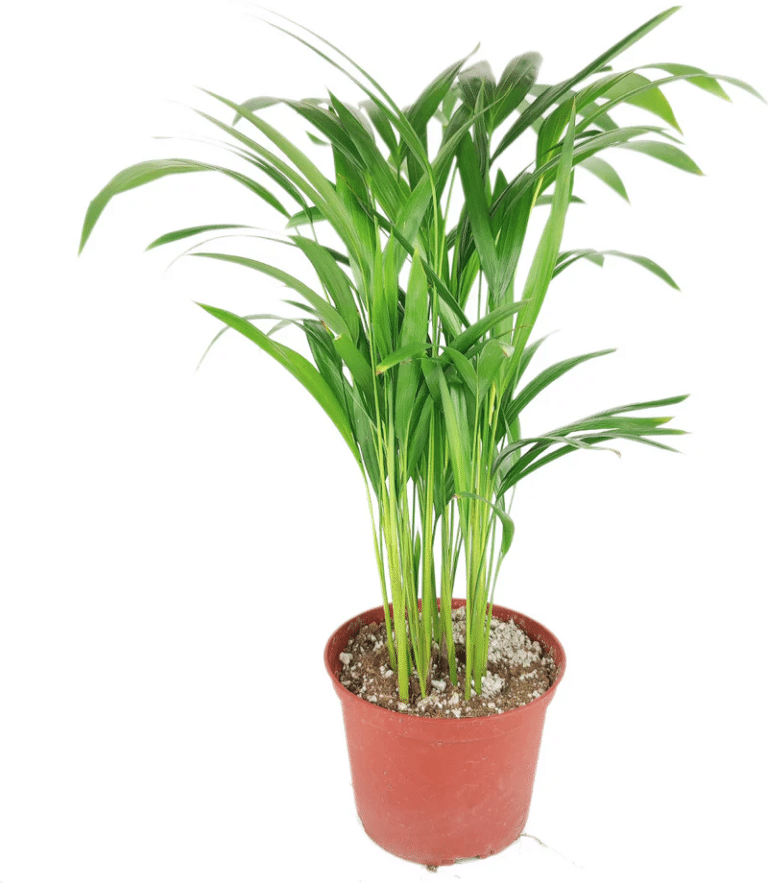
($49)
$41
“Easy to care for and looks tropical and fantastic. It’s a great addition to my home office”
4. Peperomia
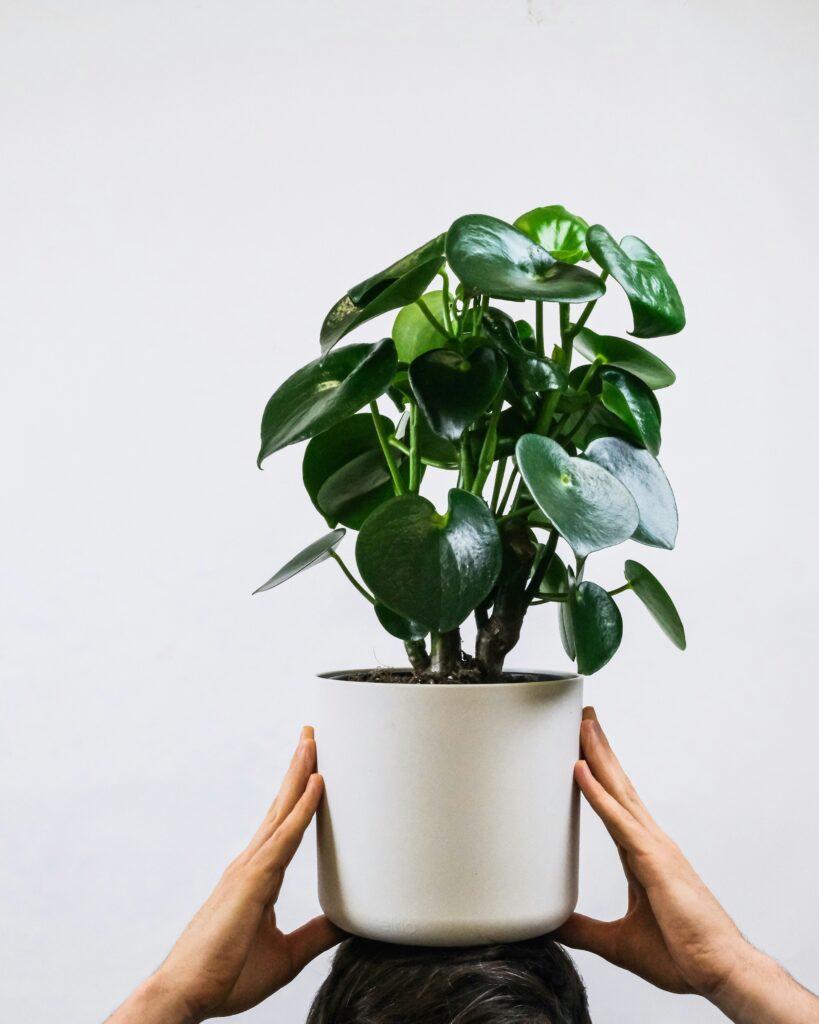
Pet safe
Low light
Grows upto 3 feet
East/North facing windows
Pet safe
low light
grows to 3 feet
East/North facing windows
The Peperomia (aka Peperomia spp.), part of the Piperaceae family, is a charming low light houseplant plant that has thick, glossy leaves that come in various shapes and patterns: from heart-shaped to rippled, and colors ranging from deep green to variegated silver and red. We have placed it in our east-facing reading room where it thrives in indirect light.
THis indoor plant is not toxic to cats and dogs. Its care level is manageable, needing watering only when the soil feels dry to the touch – typically every 1-2 weeks. This plant reaches about 6-12 inches in height. We’ve styled ours in a sleek ceramic planter that complements its modern appeal.
Care tip:
- Water your Peperomia every 1-2 weeks.
- Place it in medium bright, indirect light, such as an east-facing room.
- Watch for yellowing leaves, which can indicate overwatering
Propagation tip:
- Cut a healthy leaf with at least one inch of stem and place it in water.
- Use a jar that allows the stem to be submerged while the leaf stays above water.
- Roots should start forming in 2-3 weeks. Transfer to well-draining potting soil once roots are 1-2 inches long
Symbolism and zodiac signs:
- Symbolizes friendship and positive energy. It is a perfect match for the sociable and caring Libra
Pros and cons
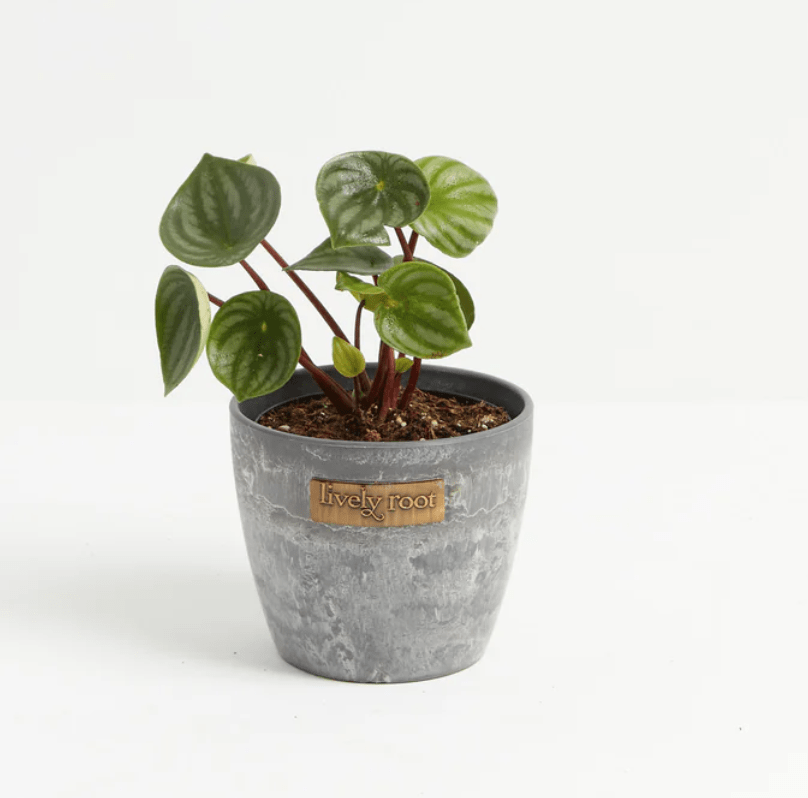
($43)
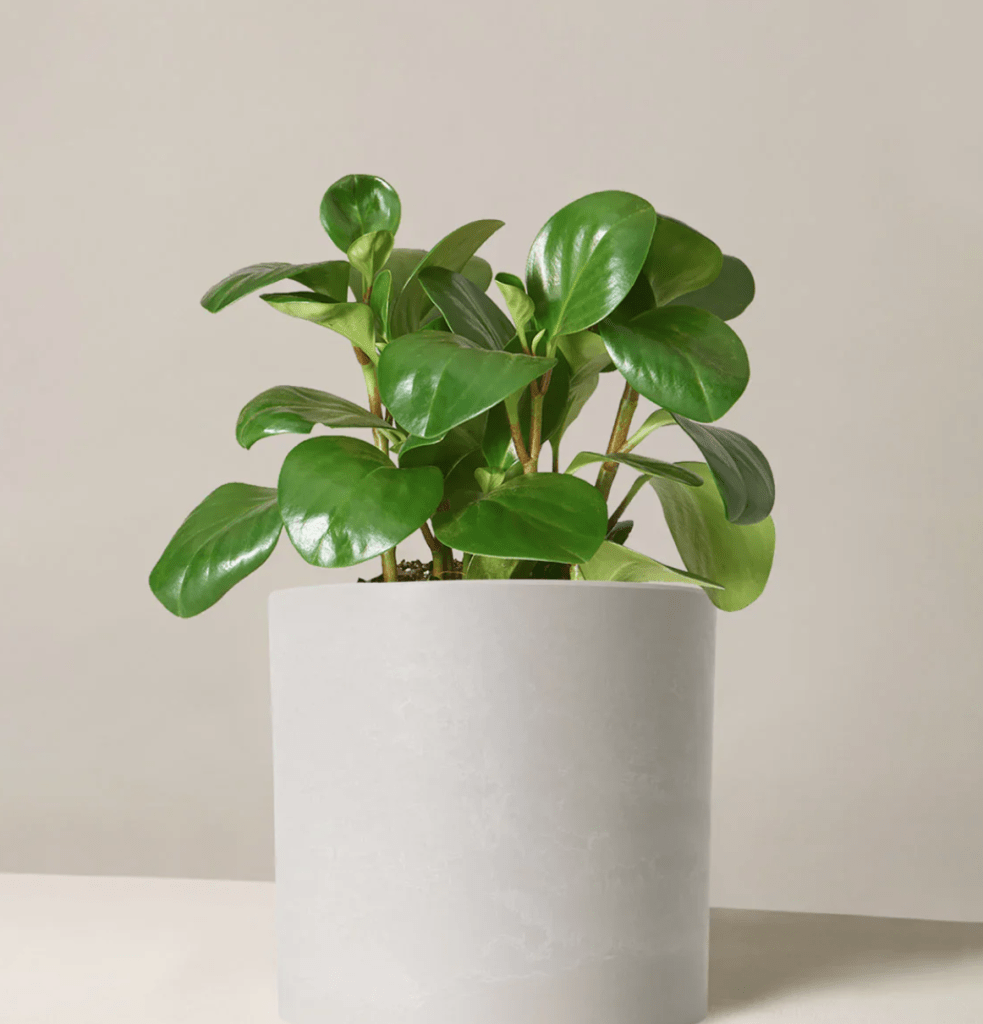
($58)

($26)
$20
“So easy to maintain. It likes to be neglected sometimes i don’t water for 3 weeks and its fine!” – Amazon customer
5. Calathea (Peacock plant)
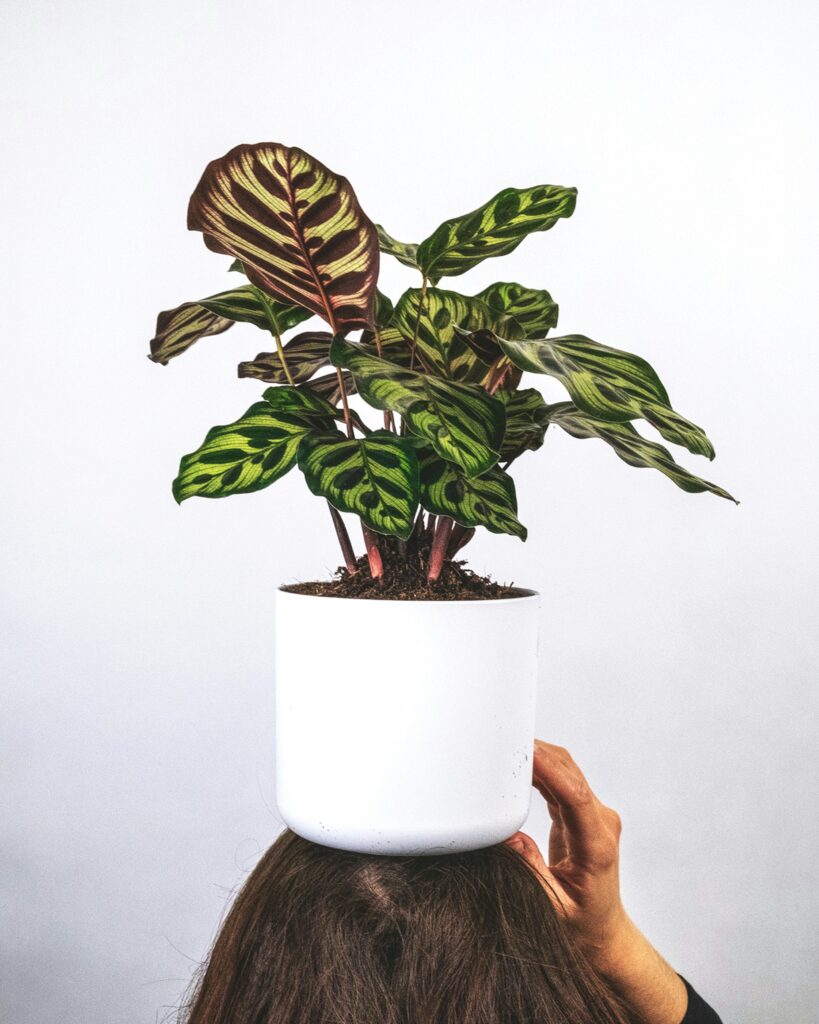
Pet safe
Low light
Grows upto 3 feet
East/North facing windows
Pet safe
low light
grows to 3 feet
East/North facing windows
The Peacock Plant (aka Calathea makoyana) is from the Marantaceae family. This low light houseplant is a true eye-catcher, especially the one which has purple leaves. Each leaf looks like a piece of art, a blend of green, white, and purple patterns that resemble a peacock’s feathers. We have placed our Peacock Plant in a beautiful ceramic planter that highlights its vibrant leaves.
This indoor plant is not toxic to cats and dogs and grows up to 2 feet tall, but it does require high humidity and consistent watering to keep its foliage looking its best. Keep an eye out for drooping leaves, which can indicate it’s thirsty or lacking humidity. This one is our house favorite, sometimes we inadvertently tend to overwater because each of us want this plant to thrive :p.
REad also: Calathea purple, and calathea Rufibarba
Care tip:
- Water it when the top inch of soil feels dry, usually once a week, and maintain high humidity by misting regularly or using a humidifier.
- Watch for curling or browning leaf edges, which indicate it needs more humidity.
- Keep it in a warm spot away from drafts and AC and heaters please!
Propagation tip:
- Divide the root clump during repotting, ensuring each division has several leaves and roots.
- Plant the divisions in well-draining soil and keep them in indirect light with high humidity.
- New growth should appear within a few weeks. Water propagation is not recommended for this plant!
Symbolism and zodiac signs:
- Symbolizes renewal and creativity, making it a perfect match for Pisces, who are known for their artistic and nurturing nature.
Pros and cons
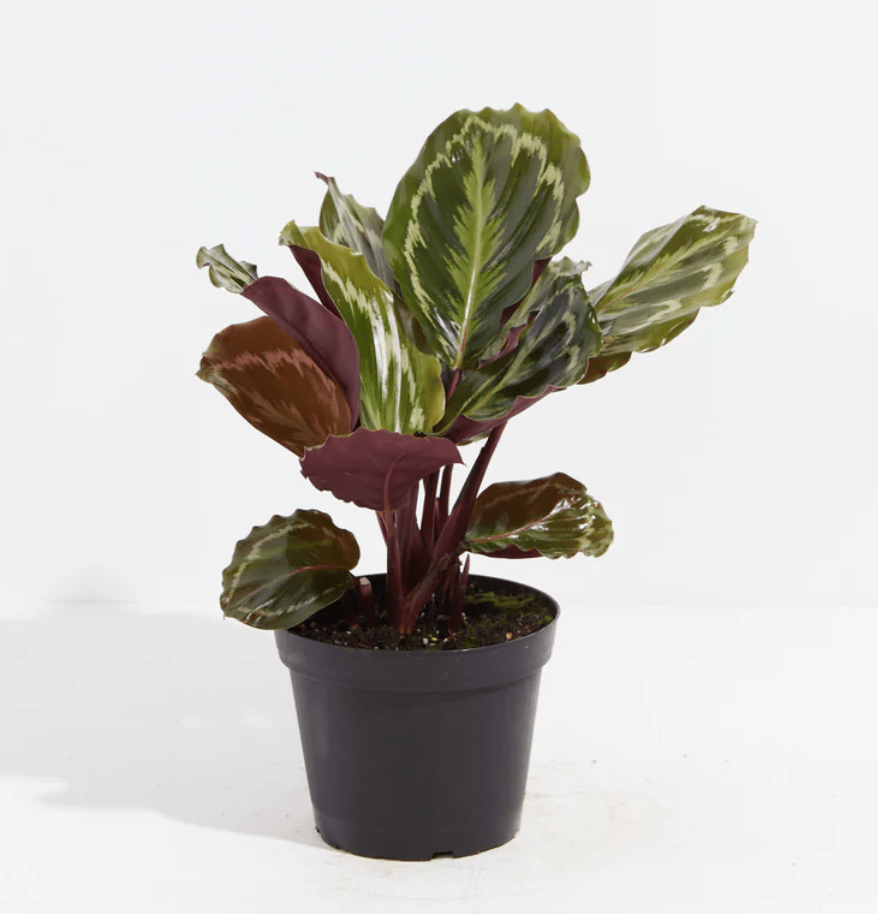
($58)

($48)
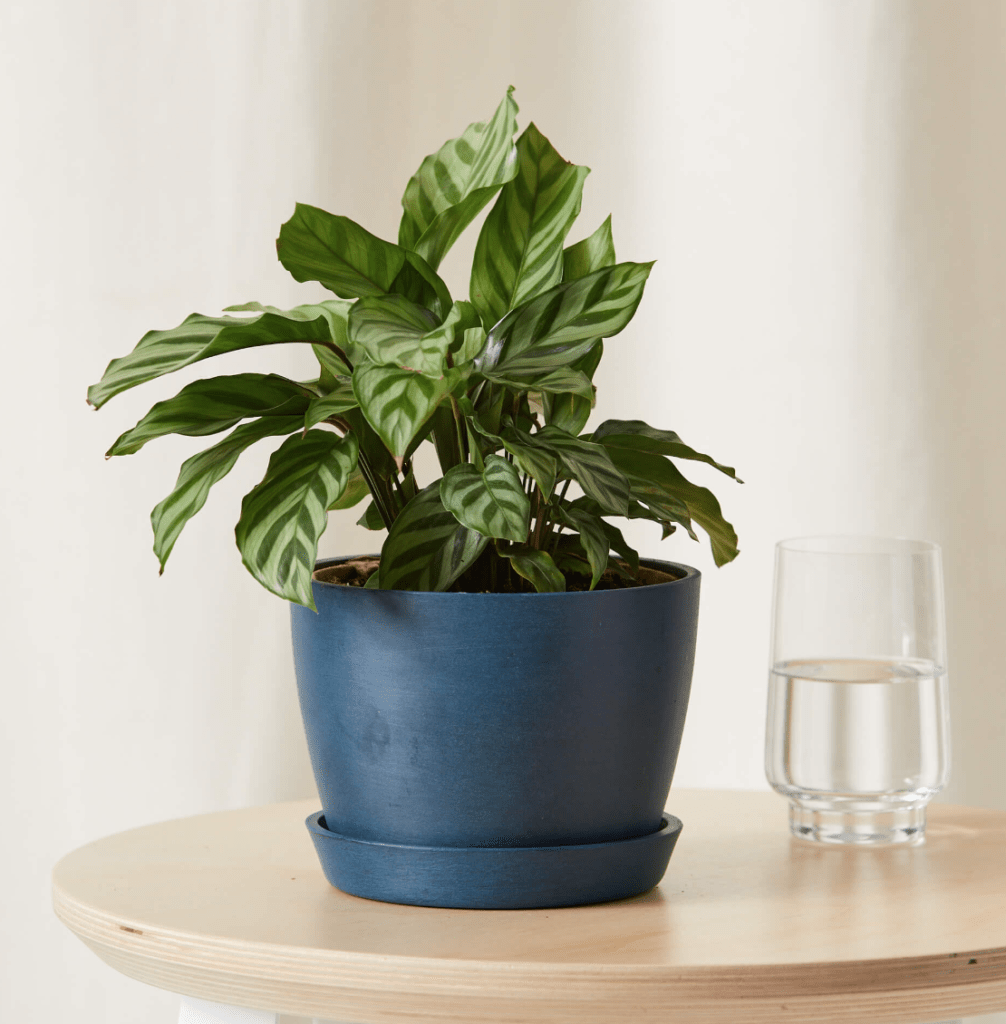
($32)
$36
“The Calathea is stunning with its vibrant patterns. It does require a bit more humidity but it’s worth it.”- Amazon customer
6. Bromeliad
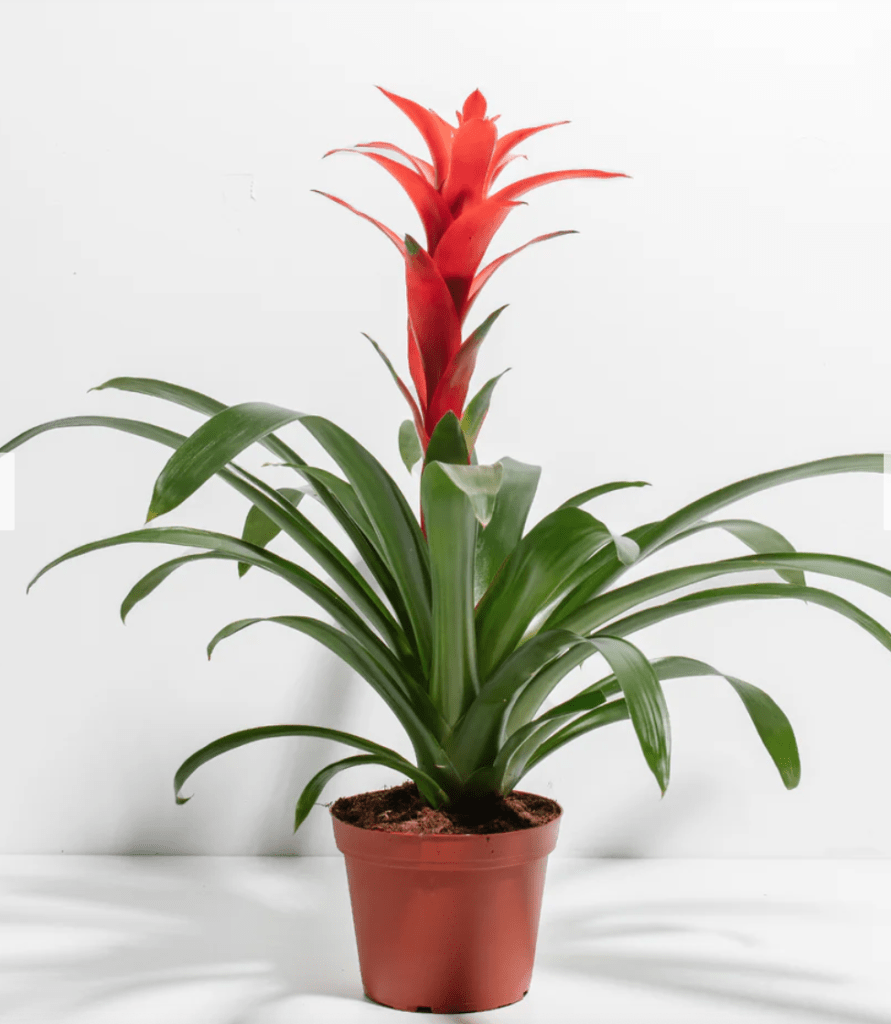
Pet safe
Low light
Grows upto 3 feet
East/North windows
Pet safe
low light
grows to 3 feet
East/North facing windows
Care tip:
- Water your Bromeliad every 1-2 weeks: central cup should be filled but not stagnant.
- Place it in indirect light – an east-facing room.
- Watch for signs of dryness, like browning leaf tips, and ensure good air circulation to prevent rot.
- Bromeliads thrive on high humidity, so mist occasionally
Propagation tip:
- Wait until the “pups” (offsets) are at least one-third the size of the parent plant, then carefully cut them off with a sterilized knife.
- Place the pups in a well-draining mix of half orchid bark and half potting soil.
- It typically takes 2-3 months for the pups to establish roots.
- Propagation in water is not recommended for this one!
Symbolism and zodiac signs:
- Symbolizes resilience and uniqueness, making it a great match for the determined and resourceful Scorpio
Pros and cons
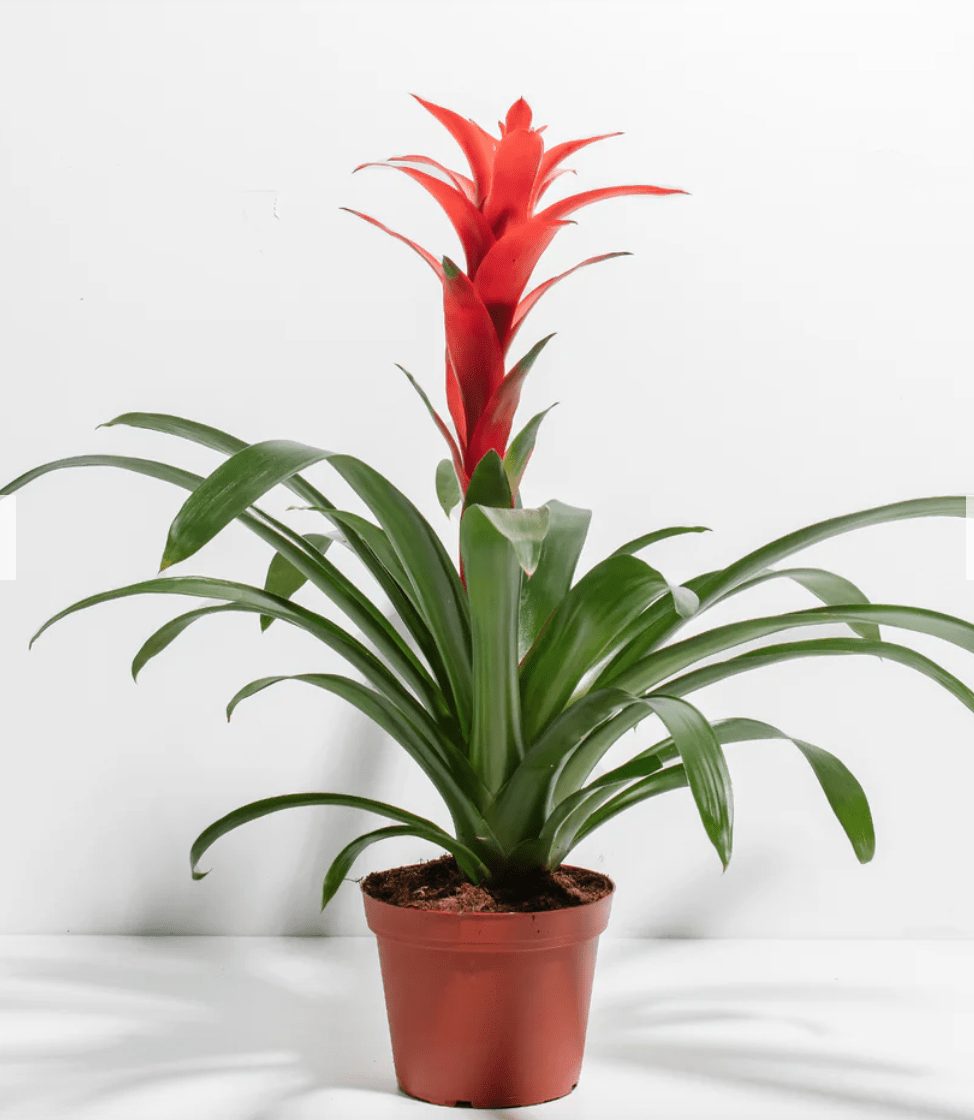
($46)
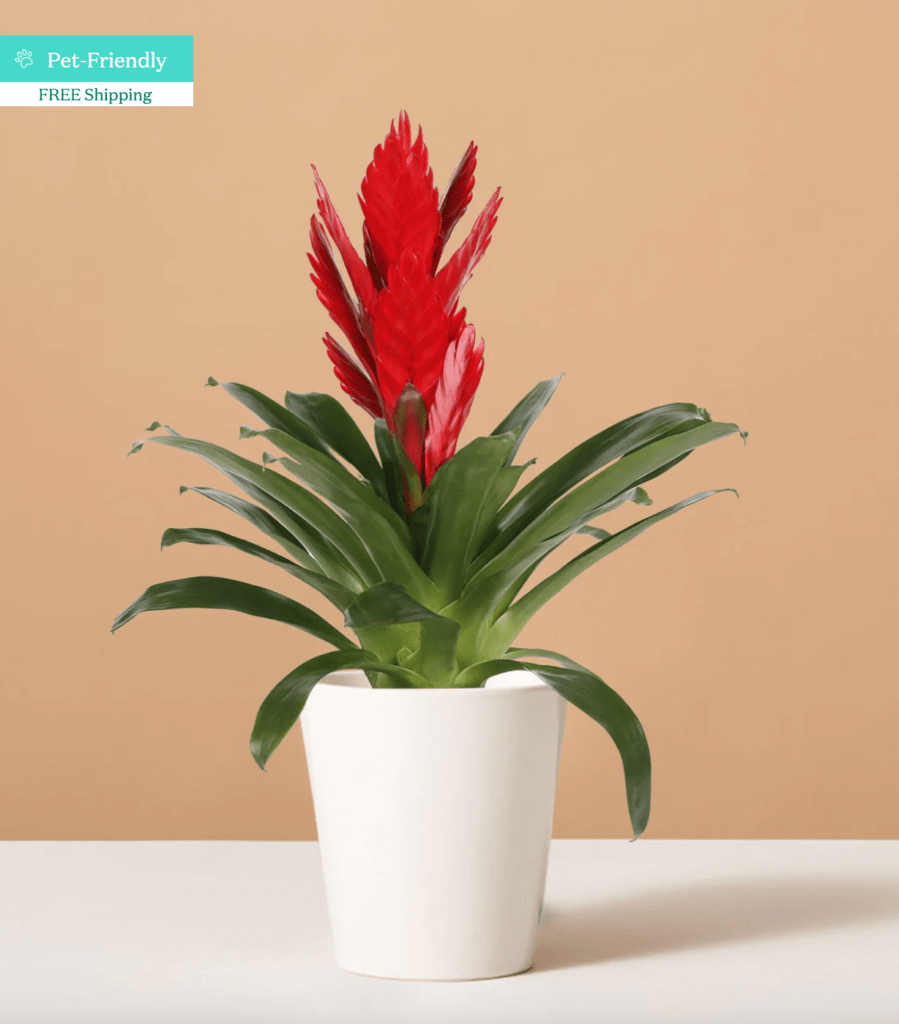
($78)

($49)
$20
“These vibrant colors in the flowers are like having bouquets all year long!” – Amazon Customer
7. Ponytail palm

Pet safe
Low light
Grows upto 6 feet
East/North facing windows
Pet safe
low light
grows to 6 feet
East/North facing windows
The Ponytail Palm (aka Beaucarnea recurvata) is low light indoor tree from the Asparagaceae family. It adds a whimsical touch with its cascading ponytail-like leaves and bulbous trunk that is infact its water reservoir. It requires very minimal care and thrives in low light conditions.
This indoor plant is not toxic to cats and dogs, so we’ve placed ours in a cream ceramic planter in the west-facing living room on the second floor where we let the cats roam. The Ponytail Palm grows slowly but can eventually reach impressive heights of up to 6-8 feet indoors.
Care tip:
- Water sparingly—allow the soil to completely dry out between waterings, as its bulbous stem stores water.
- Watering every 2 to 3 weeks should suffice, but this may vary depending on your home’s humidity and light.
- Watch for drooping leaves, which can indicate overwatering or more likely too much direct sunlight.
Propagation tip:
- Collect seeds from a mature plant and sow them in well-draining soil, lightly covering them.
- Keep the soil moist and in a warm environment with bright, indirect light.
- Germination can take several weeks to a few months. Honestly, we recommend buying a new tiny plant instead 🙂
Symbolism and zodiac signs:
- Symbolizes resilience and eternal youth due to its ability to store water in its bulbous base. Aquarius, known for embracing uniqueness and resilience, would resonate well with this plant.
Pros and cons

($12)

($58)

($35)
$28
“I forget to water this plant for weeks, and it looks the same!” – Amazon Customer
8.Orchids

Pet safe
Low light
Grows upto 3 feet
East/West facing windows
Pet safe
low light
grows to 3 feet
East/West facing windows
The Orchid (aka Orchidaceae): This plant is a stunning member of one of the largest flowering plant families, and has vibrant pink blooms, and mysterious deep purples, and every color in between, emitting a curious but delicate fragrance that vary across species.
We’ve placed our orchids in one of our east-facing room where they receive the bright, indirect sunlight. Here, they’re styled in sleek glass pots that not only complement the delicate beauty of the orchids but also allow us to monitor the moisture levels of the roots easily. Orchids are more manageable than many believe — they require watering every week or so!
Care tip:
- Water them once a week. Keep an eye for limp leaves, a sign of too much water or insufficient light.
- Orchids enjoy humidity, so a bathroom with a window can be ideal spots.
Propagation tip:
- Remove a keiki (baby plant) with roots, ensuring roots are at least 2 inches long.
- Plant it in a well-draining orchid mix (ideally), and keep it in bright, indirect light. Roots should establish in a few weeks
Symbolism and zodiac signs:
- The Orchid symbolizes beauty, love, and strength — apt for Virgos who appreciate detail and elegance in their surroundings.
Pros and cons

($66)
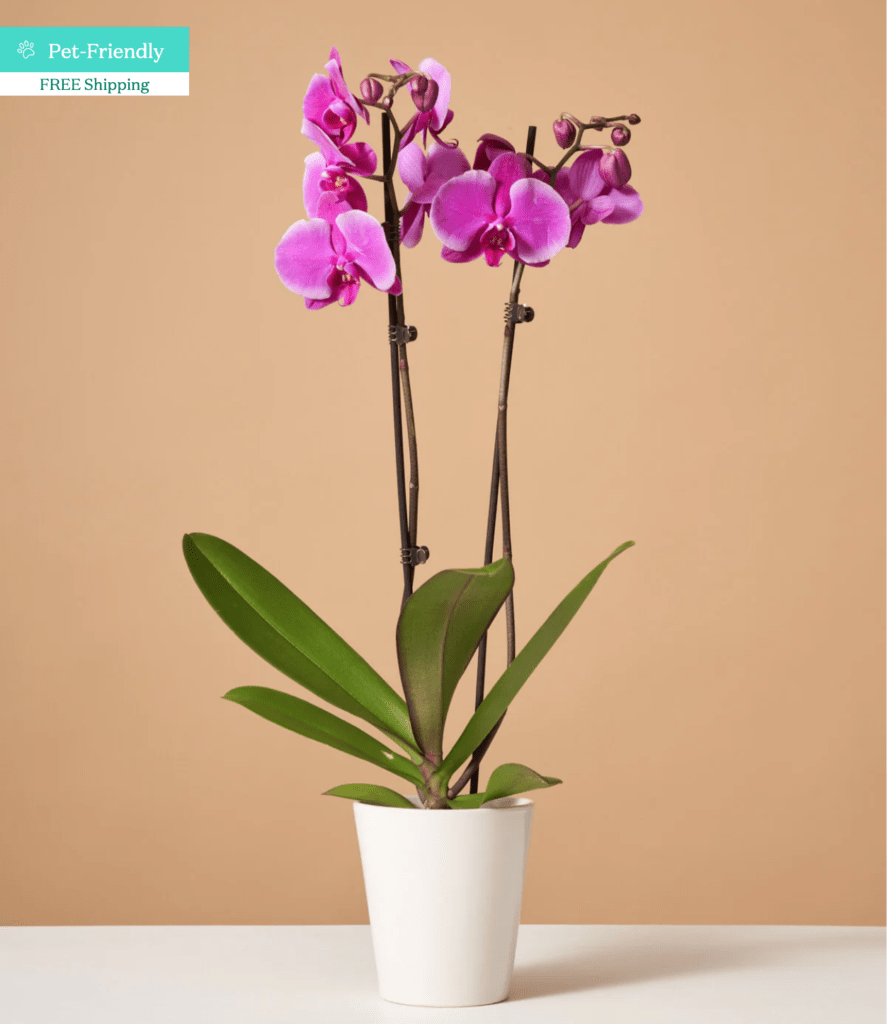
($88)
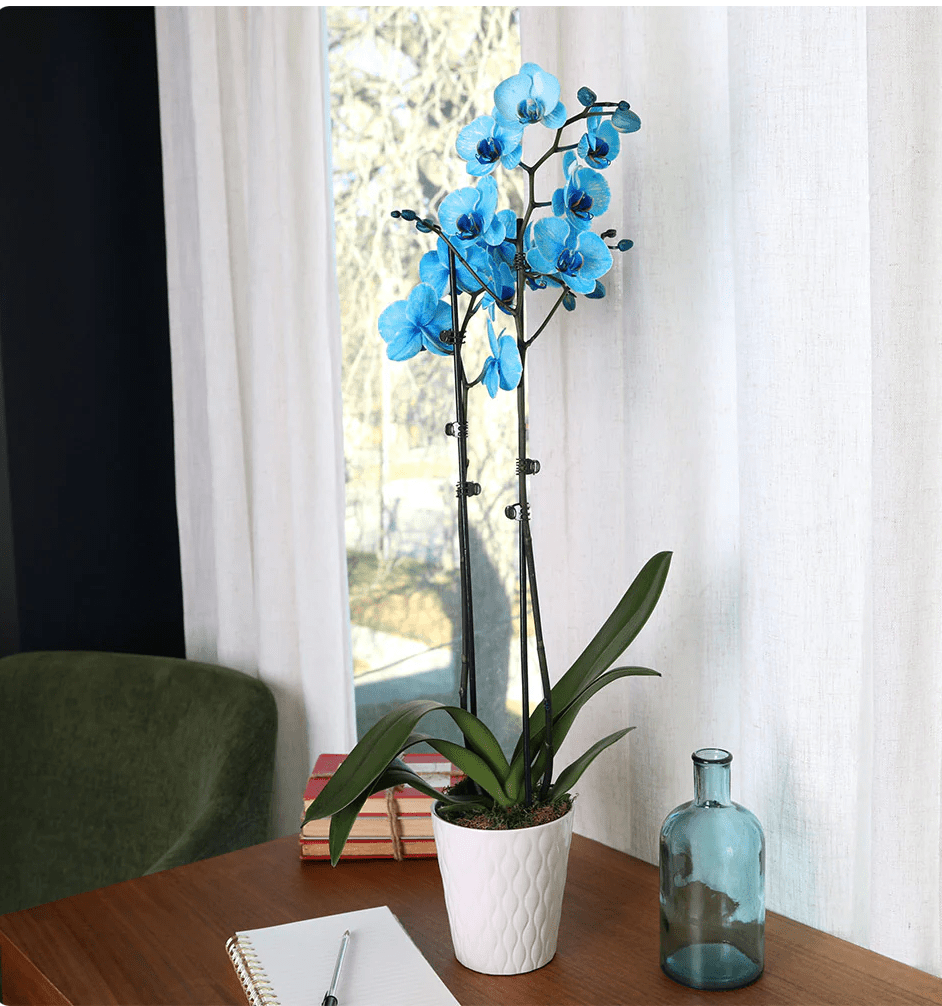
($49)
$24
“I love the elegant blooms of this orchid. It’s very easy to care for and adds a touch of elegance to my home” – Amazon customer
9.Bamboo palm

Pet safe
Low light
Grows 4-12 feet
East/West facing windows
Pet safe
low light
grows to 4-12 feet
East/West facing windows
Bamboo Palm (aka Chamaedorea seifrizii): This plant, from the Arecaceae family, has graceful, arching fronds and feathery green leaves. Our living room at once feels tropical with this large plant in it! It is currently placed ours in the west-facing living room in second floor where pets are welcome to roam around.
Bamboo Palms are also easy to care for. They don’t really have a notable fragrance, but they do occasionally produce small, yellow flowers. We have styled the Bamboo Palm in a tall, cream pot that complements its height. This one is a big plant – it can reach up to 12 feet tall – making it a stunning focal point. Most importantly, this indoor plant is not toxic to cats and dogs!
Care tip:
- Water when the top inch of soil feels dry, usually every 1-2 weeks.
- Soil should drain well to prevent root rot. Yellowing leaves indicate overwatering.
Propagation tip:
- Remove a clump with 2-3 stems and roots.
- Plant it in well-draining soil mixed with (ideally) perlite.
- Keep the soil moist, and place it in bright, indirect light. Roots come in 4-6 weeks!
Symbolism and zodiac signs:
- Symbolizes good luck, prosperity, and resilience. Ideal for Capricorns who appreciate its hardworking and enduring nature
Pros and cons
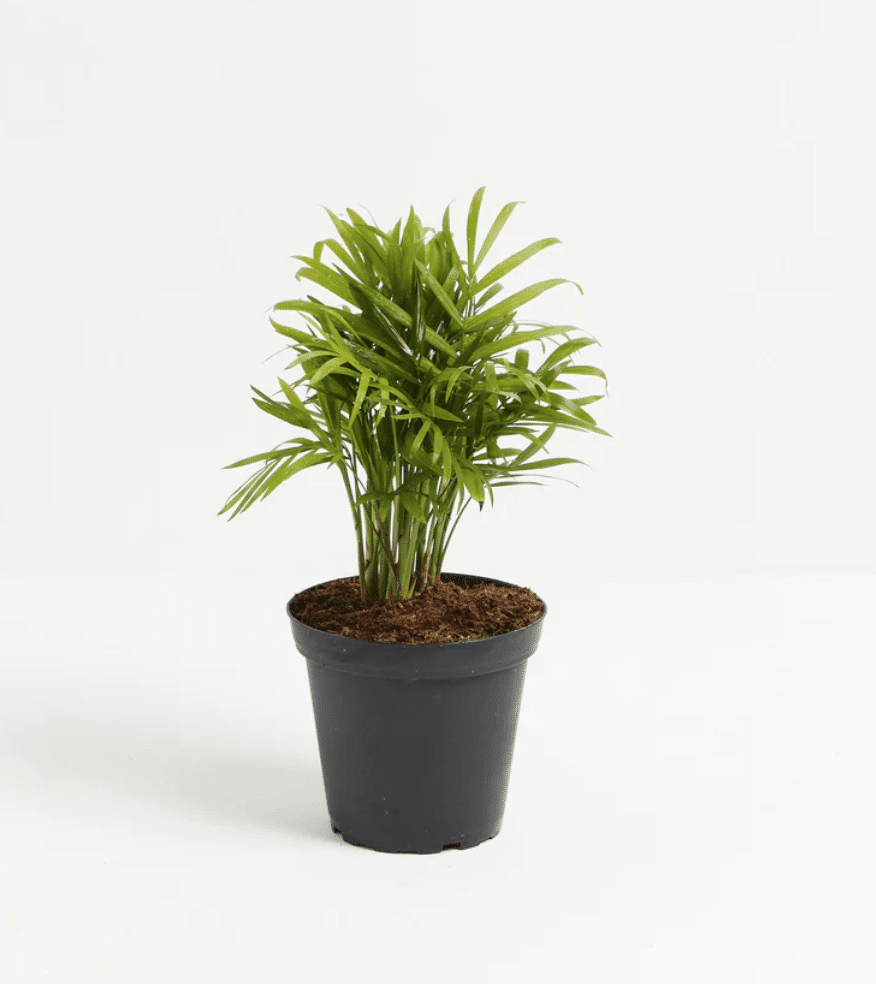
($43)
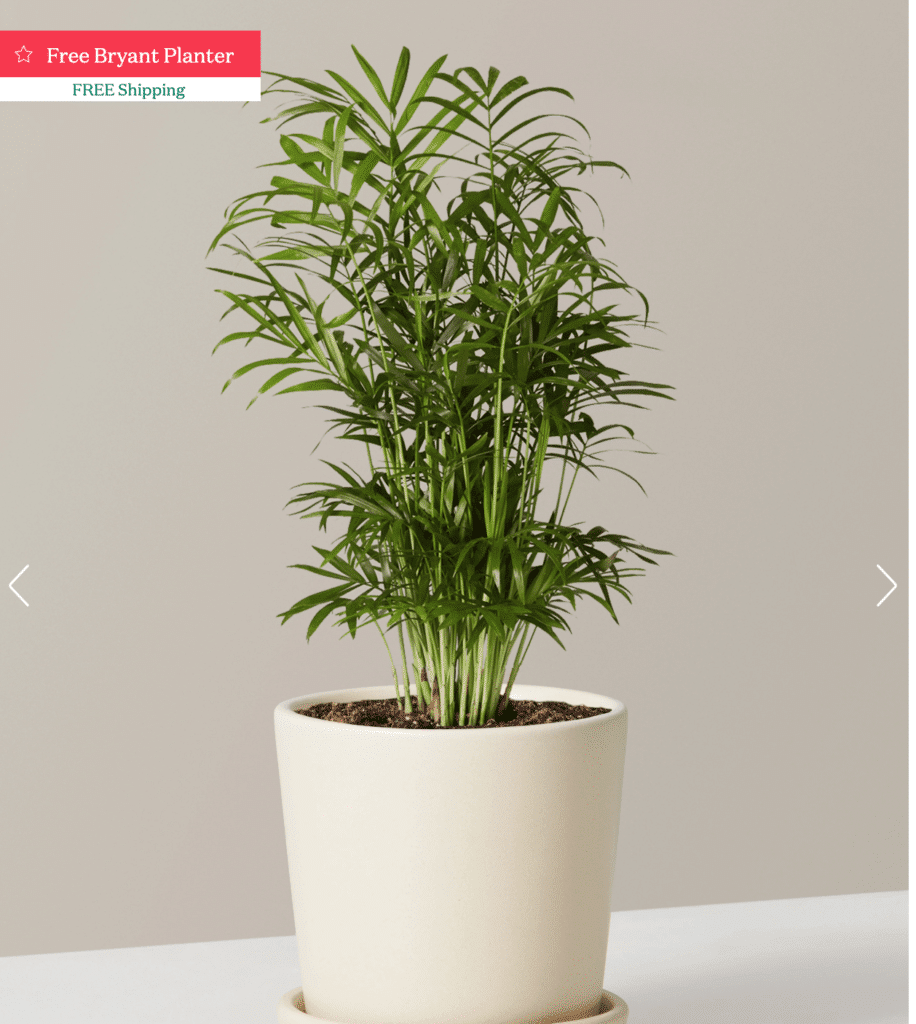
($38)

($35
$28
“This plant is a bit finicky but looks stunning when healthy. It’s definitely a statement piece”
10.Money Tree
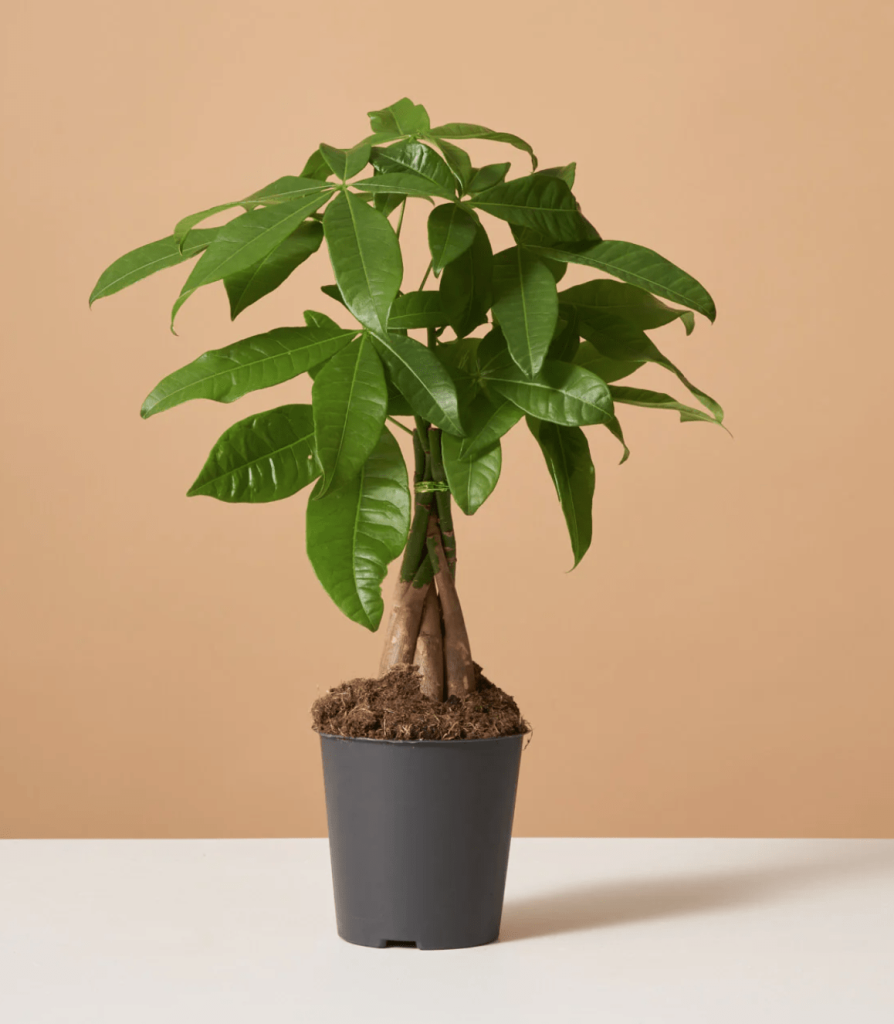
Pet safe
Low light
Grows 8 feet
North/East/West facing windows
Pet safe
low light
grows to 8 feet
North/East/West facing windows
The Money Tree (aka Pachira aquatica) is a low light indoor tree from the Malvaceae family. Its distinctive braided trunk and lush, green leaves fanning out like a plume, adds a visual punch to any room. But is also famed for bringing good luck and prosperity. We’ve placed ours in the west-facing room on the first floor where our cats roam free.
This hardy plant is wonderfully easy to care for, and is not toxic to cats and dogs! It thrives with just moderate watering and can grow up to six to eight feet tall. We’ve chosen a sleek, golden planter that complements its vibrant green leaves – this one no doubt is a house favorite!
Care tip:
- Aim to water it every 1-2 weeks, allowing the soil to dry out slightly between waterings.
- Keep an eye out for yellowing leaves, which might indicate overwatering.
- A standout feature of this plant is its braided trunk that helps the tree store moisture, so occasional neglect in watering is often forgiven 🙂
Propagation tip:
- Select a healthy stem and cut a 6-inch piece just below a leaf node.
- Remove the leaves near the cut to prevent rotting.
- Place the stem in a glass of water, ensuring no leaves are submerged.
- Refresh the water weekly and keep the glass in a spot with indirect sunlight. Roots typically appear in about 4 weeks
Symbolism and zodiac signs:
- Symbolizes prosperity, good fortune, and financial success. Capricorns, known for their practicality, patience, and ambition, are particularly well-suited to nurture this plant.
Pros and cons
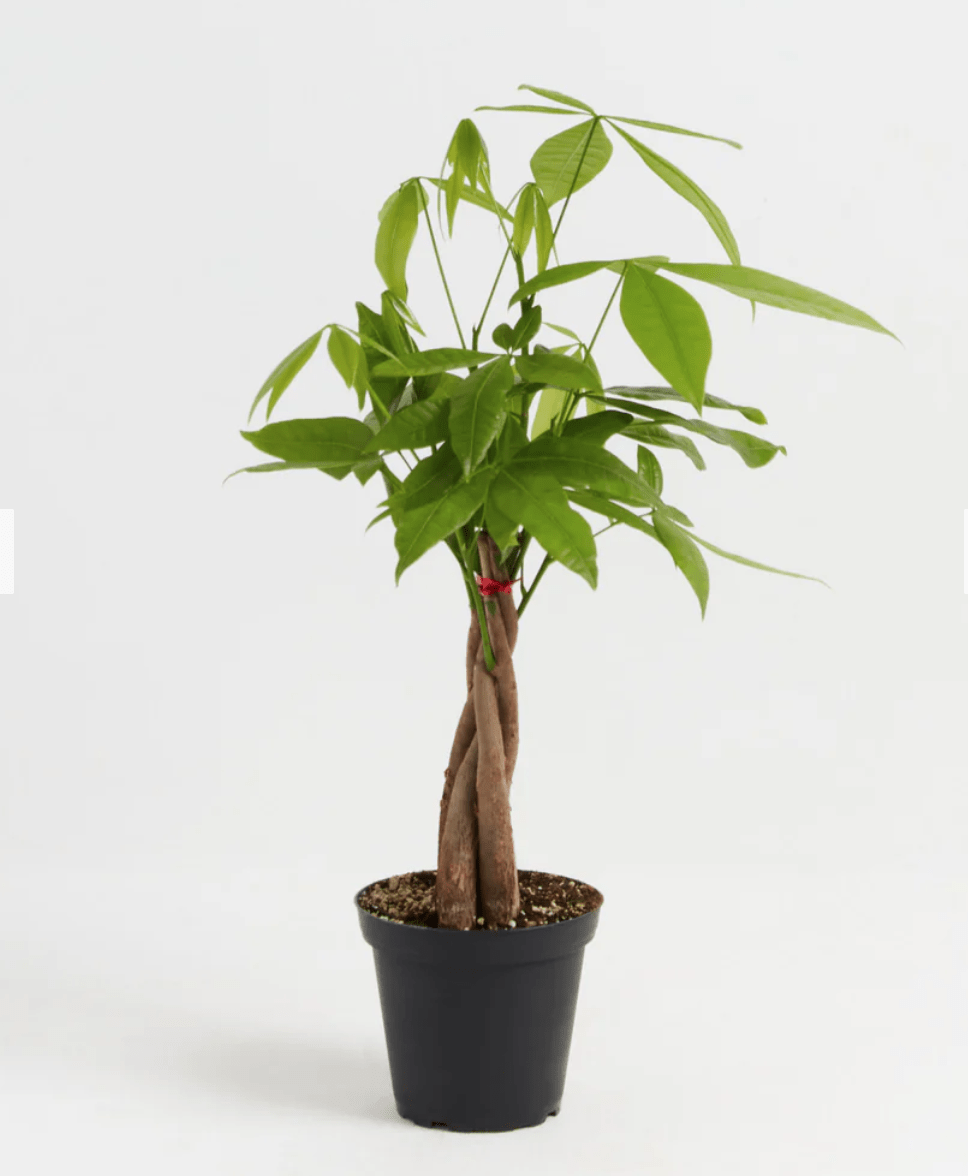
($43)
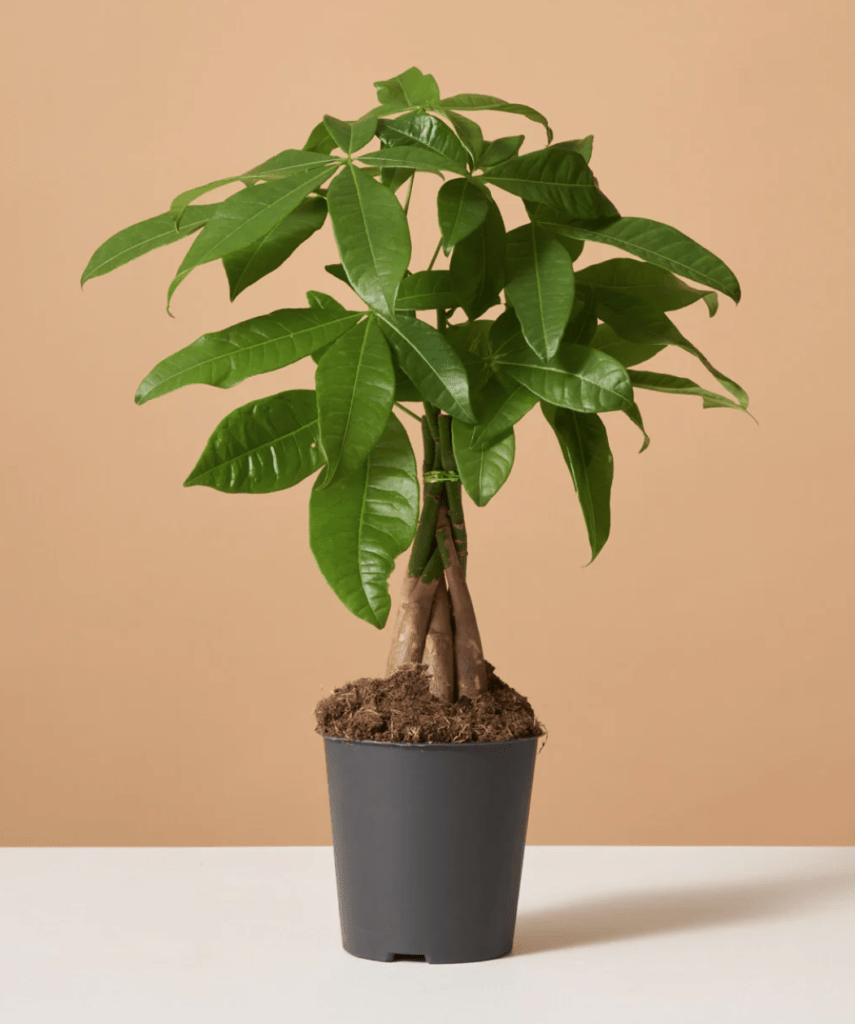
($48)
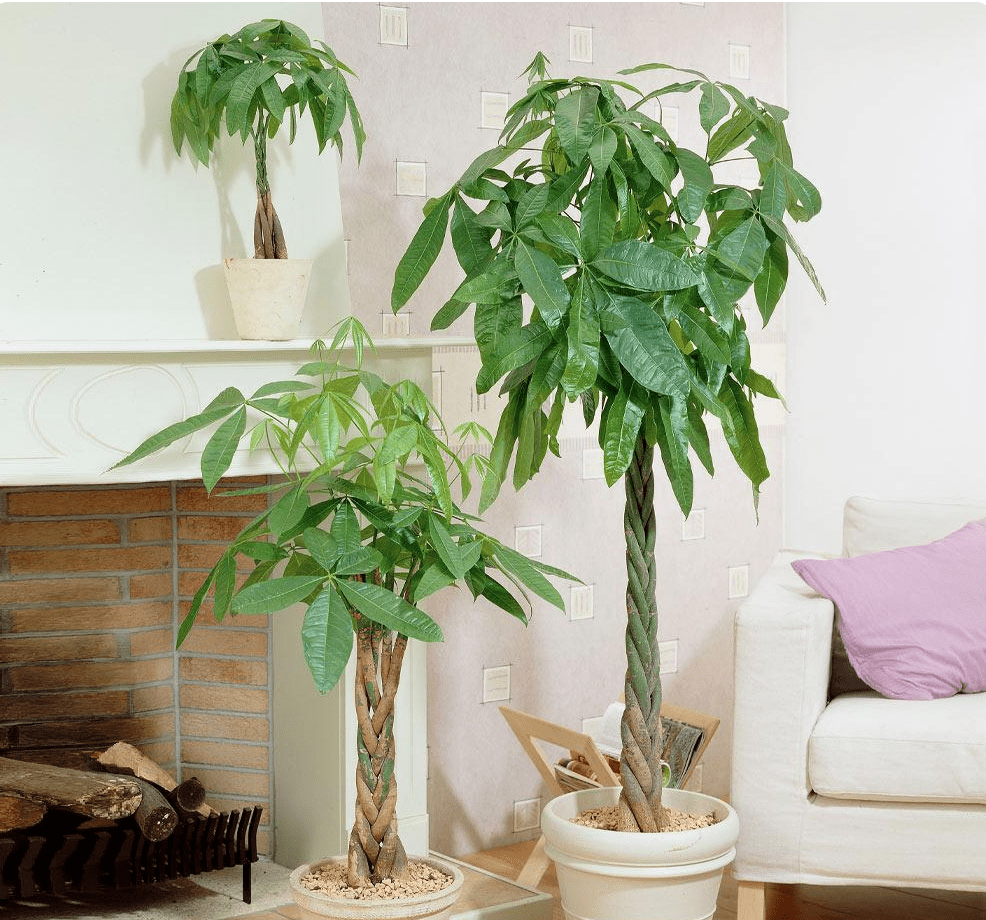
($39)
$33
“For over five years, this plant has been such a resilient and forgiving addition to my living room”
11.Hoya Plant

Pet safe
Medium light
Grows 3 feet
North/East/West facing windows
Pet safe
low light
grows to 3 feet
North/East/West facing windows
The Wax Plant (aka Hoya) belongs to the Asclepiadaceae family and has become a standout addition to our home. This one is surely one those rare houseplants we are proud to keep growing. We have placed it in the west-facing bedroom on the first floor. Its waxy leaves glisten under the sunlight, and capture our guests attention with their unique shapes and sometimes even speckled or marbled patterns. During spring, the Hoya surprises us with clusters of sweet-scented, star-shaped flowers that seem almost sculpted from wax — trust us, this is a keeper! We’ve chosen a rustic terracotta hanging planter for it, enhancing the organic elegance it lends to the space. This plant is not toxic to cats and dogs and is also very forgiving and thrives in neglect!
Care tip:
- Place it in a spot that gets medium to bright, indirect sunlight.
- Water your hoya only when the soil has completely dried out—about every 10 to 14 days, and less frequently in winter. Hoyas store water in their leaves.
- These plants thrive in average household humidity and prefer temperatures between 60-85°F.
- Avoid pruning the flower stalks after blooming as they will rebloom from the same spurs
Propagation tip:
- Cut a 4-5 inch stem below a node, strip lower leaves, submerge one node in water, and place in bright, indirect light.
- Change water every few days. Expect roots in about a month, then pot in soil
Symbolism and zodiac signs:
- Symbolizes protection and spiritual healing. Individuals born under the zodiac sign of Cancer are well-suited to care for this plant!
Pros and cons

($35)

($48)

($39)
$23
“hoya plant feels so exotic. This is one plant I rarely see in other households and is so easy to manage!” -Amazon Customer
12.banana Plant
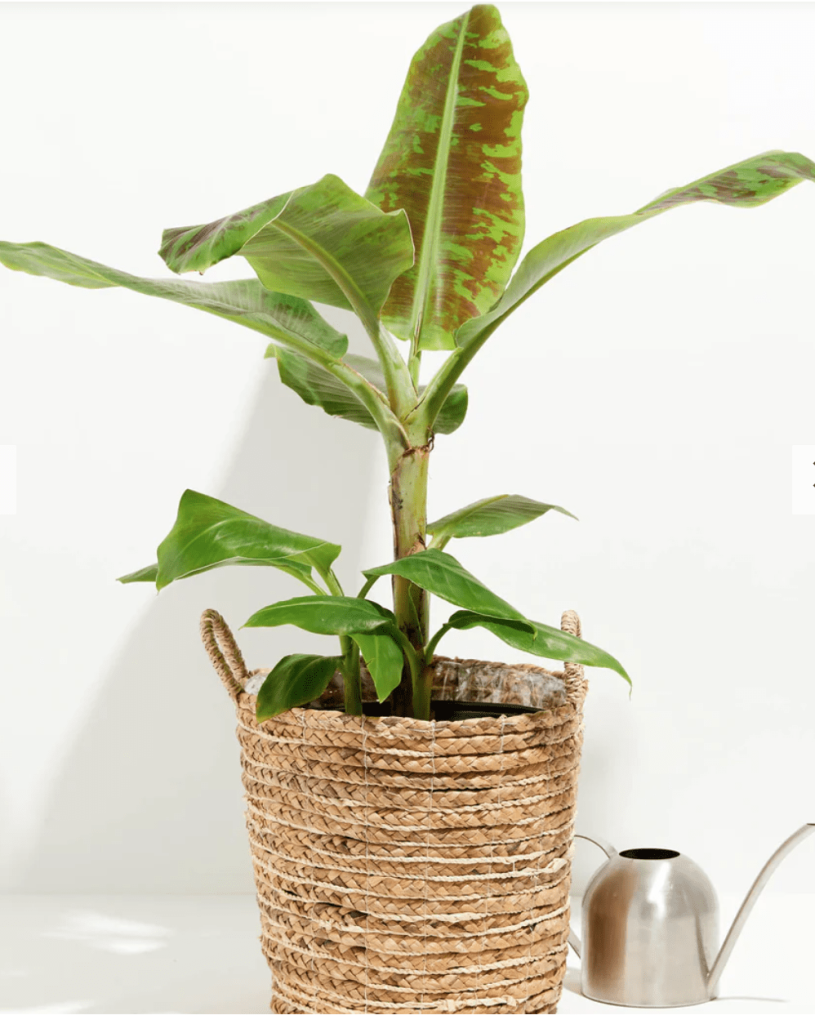
Pet safe
Bright light
Grows 12 feet
South facing windows
Pet safe
Bright light
grows to 12 feet
South facing windows
The Banana Plant (aka Musa spp.) is a member of the Musaceae family. This pet-safe plant brings a lush, tropical vibe to any indoor setting. Its broad, arching leaves unfurl to reveal delicate veins and a vibrant green shade. We have placed our Banana Plant in the south-facing living room in the first floor where it basks in the bright, direct sunlight it loves.
This unfortunately does need bright direct light, and when it get it, it will grow 12 feet! It’s also manageable with regular watering and monthly feeding during its growing season. This indoor plant is not toxic to cats and dogs, fortunately. Fruit production is more common in outdoor settings with continuous care, but it’s possible indoors, we have heard, if the plant receives enough light and care. The process from flowering to fruiting can take several months, and it provides a unique and exciting aspect to growing this plant indoors, and we are hoping to see it happen in our home!
Care tip:
- Loves lots of light, so place it in a south-facing window where it can enjoy bright, direct sunlight.
- Water it thoroughly but allow the soil to dry out slightly between waterings, typically once a week.
- It’s a fast grower, especially in the right conditions, so keep an eye out for yellow leaves, which might indicate overwatering or poor drainage.
- High humidity will help keep its large leaves fresh and prevent them from browning at the edges
Propagation tip:
- Select a healthy sucker or offset with roots, about 6 inches tall.
- Plant it in well-draining potting mix, ensuring the roots are covered but the stem remains above the soil.
- Keep it in a warm, humid environment and expect new growth within 6-8 weeks.
Symbolism and zodiac signs:
- Symbolizes prosperity, abundance, and tropical vibes, making it particularly appealing to those born under the sign of Taurus, who appreciate stability, luxury, and natural beauty
Pros and cons
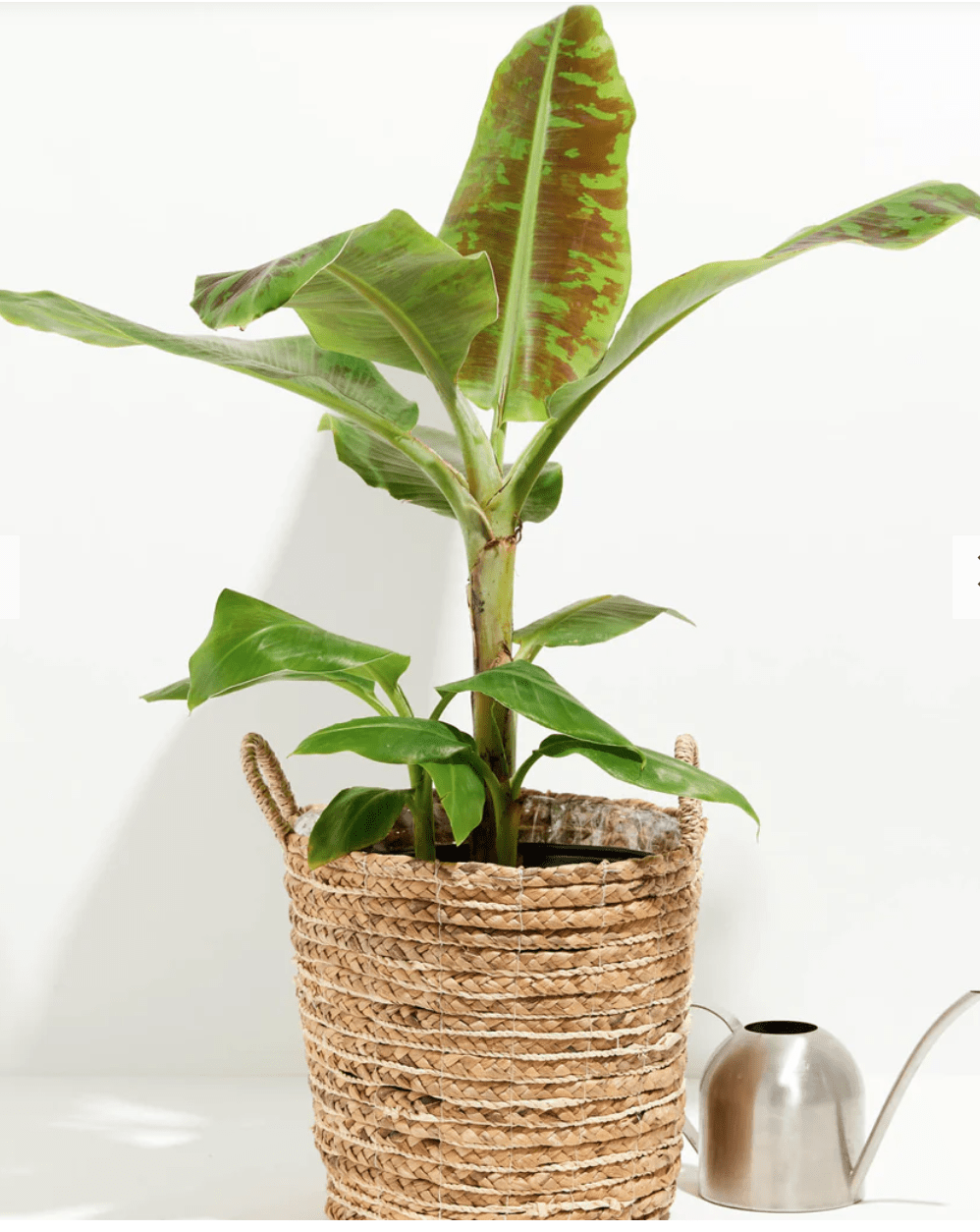
($99)
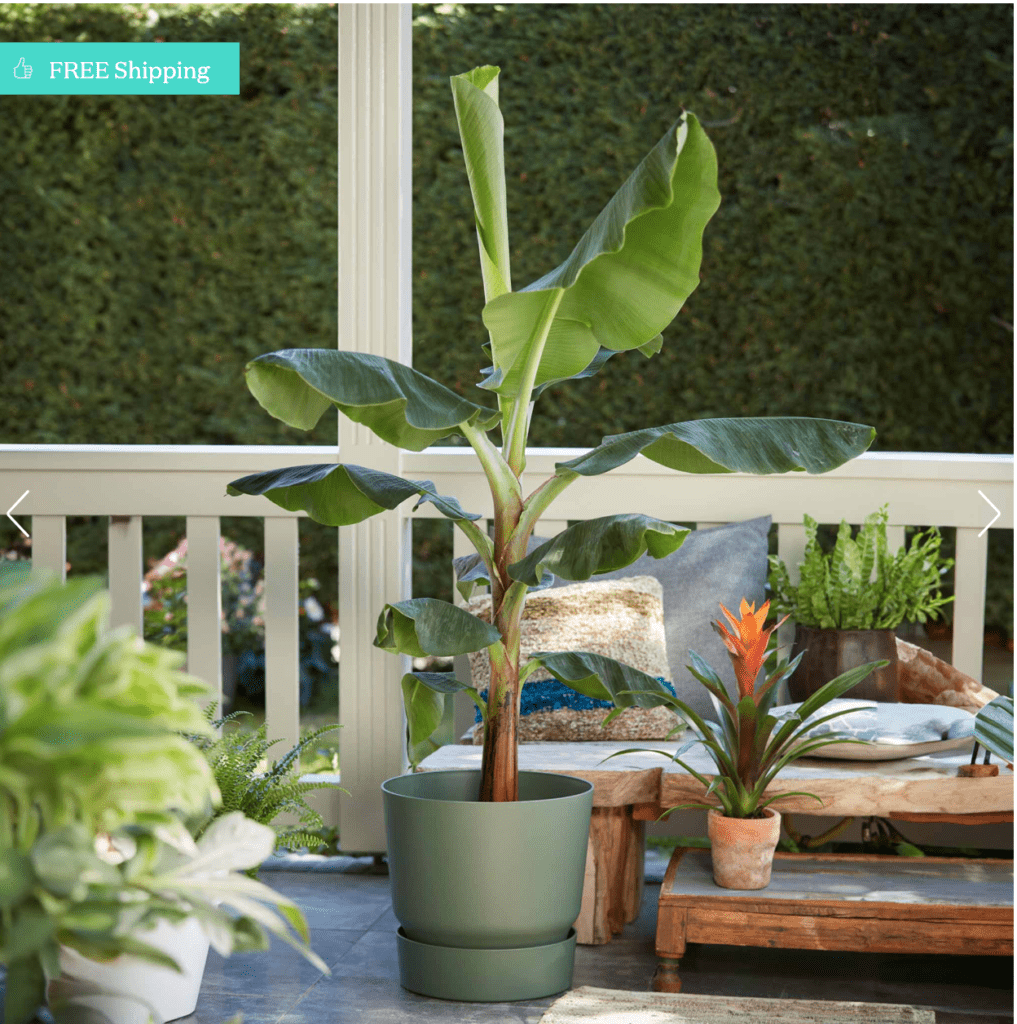
($36)
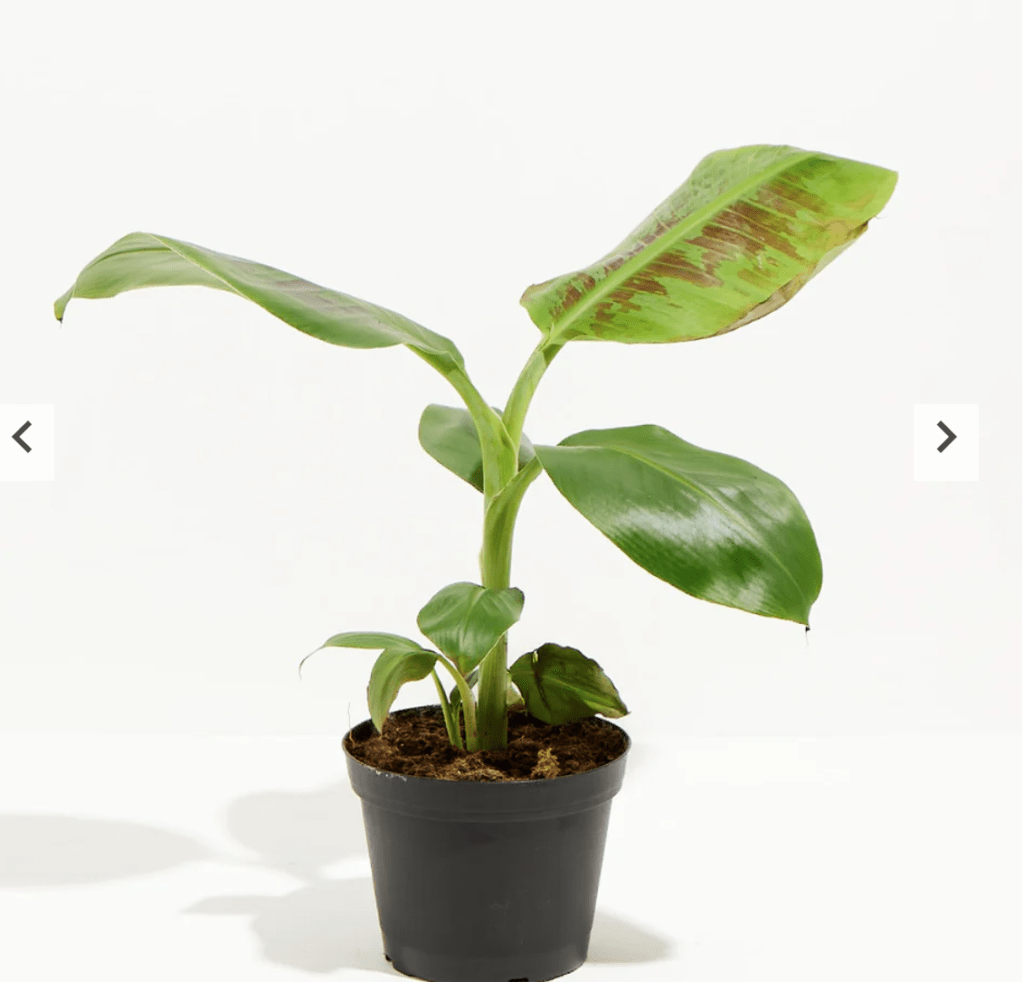
($58)
$24
“I love how large the leaves are. This plant requires regular watering but is worth it for the bold foliage. Needs direct light though”
13.Cast iron Plant

Pet safe
Medium light
Grows 3 feet
North/East/West windows
Pet safe
low light
grows to 3 feet
North/East/West facing windows
The Cast Iron Plant (aka Aspidistra elatior): This air purifying indoor plant, from the Asparagaceae family has long, glossy, dark green leaves. This plant is incredibly tolerant and thrives in low light, surviving infrequent watering. We’ve placed ours in the dining room on the first floor where it handles the low light beautifully. Styled in a classic terracotta pot, it brings a warm and rustic feel to our eating nook. The Best thing is that this beautiful plant is not toxic to cats and dogs! When it grows, it can reach up to 2-3 feet tall and wide — a perfect hardy and attractive plant that creates a sense of sanctuary with little to no effort.
Care tip:
- Thrives in low to medium light and needs watering only when the top inch of soil is dry — about every 2-3 weeks.
- Watch for yellowing leaves that can indicate overwatering. This is a hardy plant 🙂
Propagation tip:
- Divide the root clump with at least 2-3 leaves and healthy roots, and then plant divisions in well-draining potting soil.
- Keep in low to medium light.
- Watering only when the top inch of soil is dry. New growth will appear in a few weeks.
Symbolism and zodiac signs:
- The Cast Iron Plant symbolizes endurance and resilience — it ideal for Capricorns who value perseverance and stability
Pros and cons
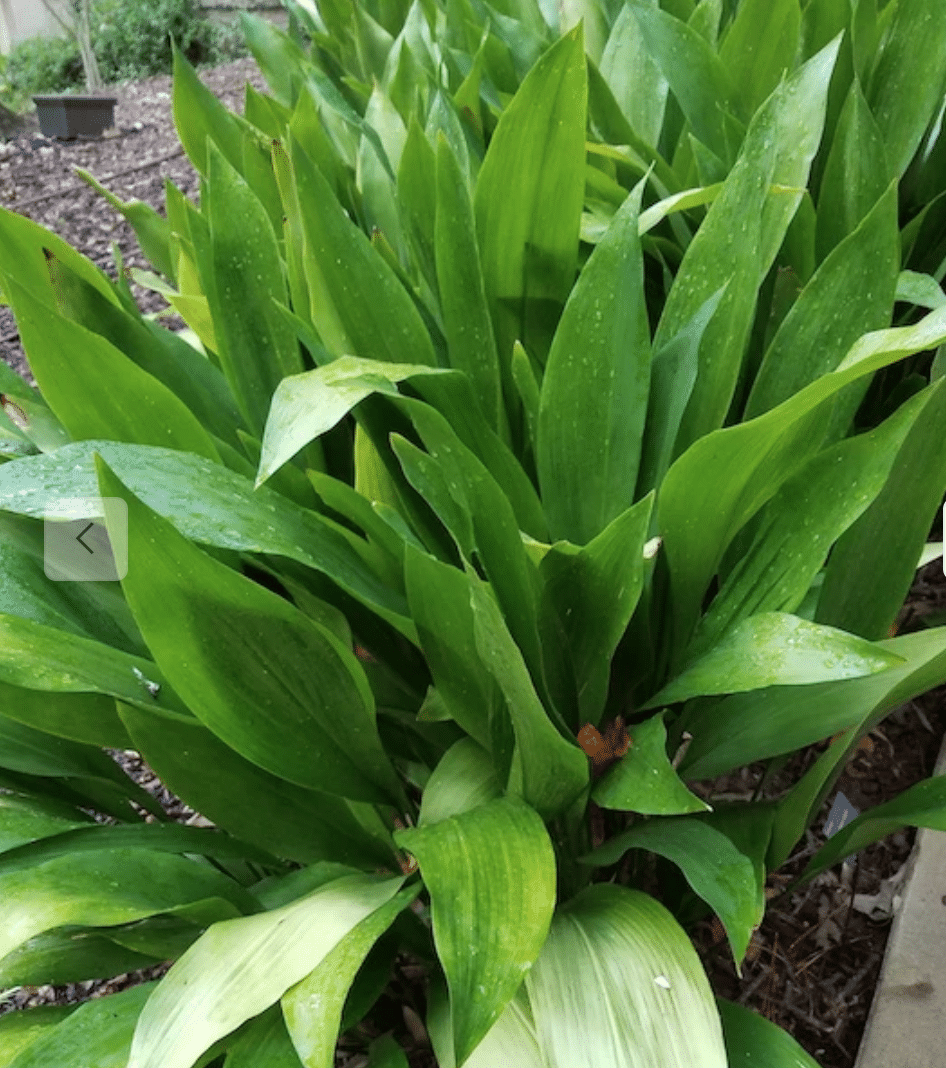
($49)

($78)
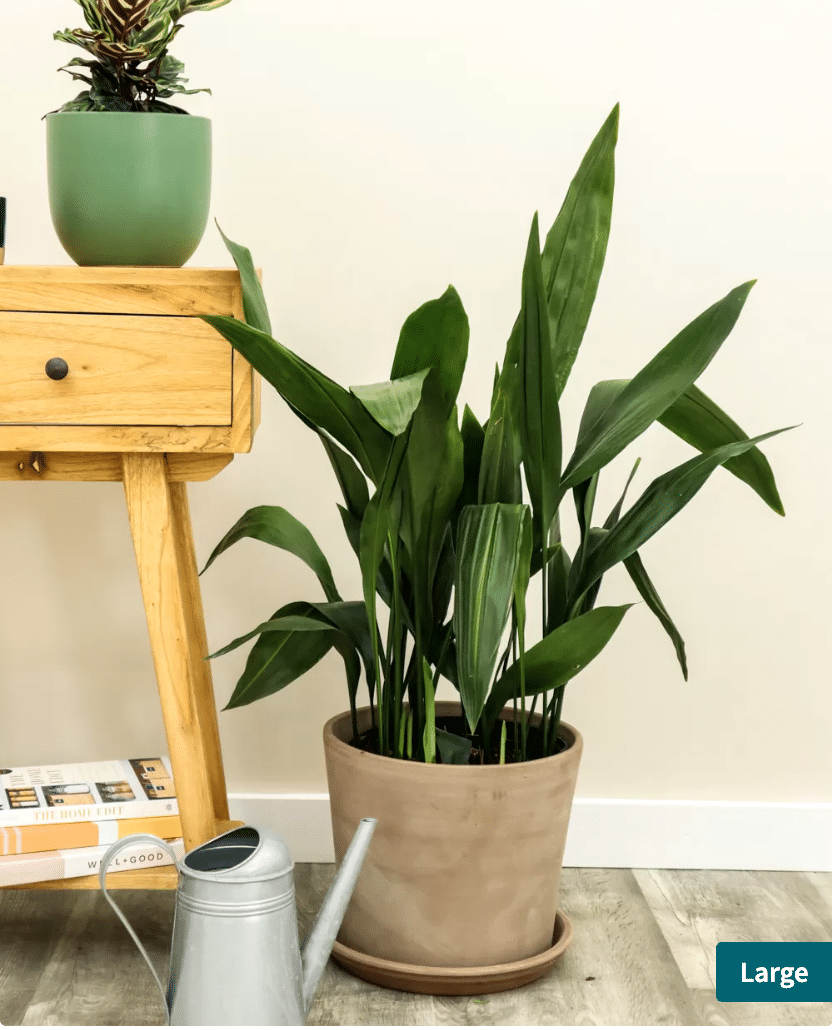
($90)
$44
“The Cast Iron Plant is perfect for anyone who wants a hardy, low-maintenance plant. Mine arrived in perfect condition and looks great” – thesill.com customer
14.Parlor palm
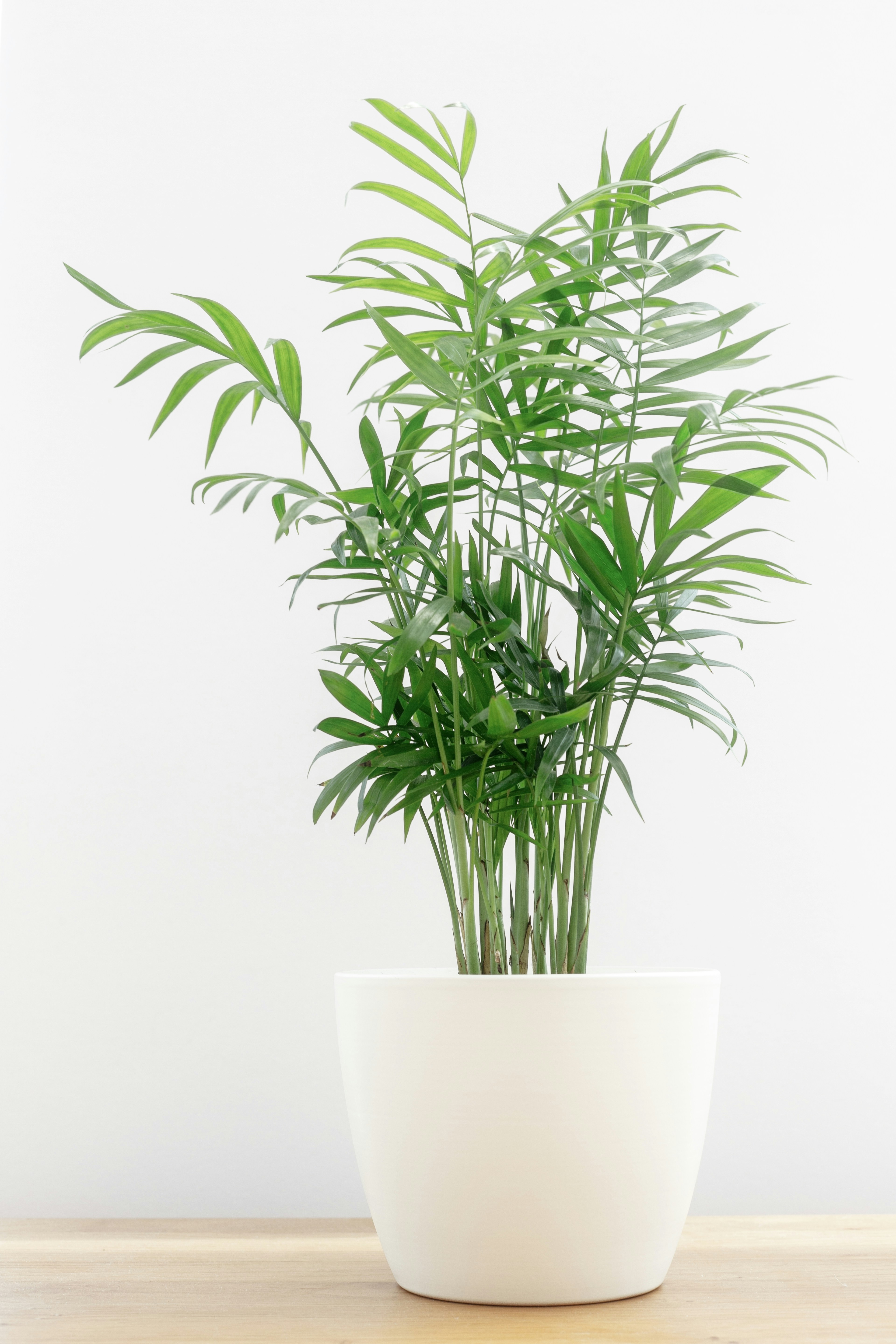
Pet safe
Medium light
Grows 6 feet
North/East/West facing windows
Pet safe
low light
grows to 6 feet
North/East/West facing windows
The Parlor Palm (aka Chamaedorea elegans) is a low light houseplant from the Arecaceae family. It is a classic favorite for indoor plant enthusiasts, known for its lush, green fronds that arch from delicate stems. We have styled ours in a terracotta pot. Its not toxic to cats and dogs. It’s a easy care plant, requiring only occasional watering, and as it grows, the Parlor Palm can reach up to 6 feet in height. While it doesn’t typically flower indoors, we have heard it might surprise you with small, inconspicuous flowers! It brings in a bit of tropics into our home.
Care tip:
- Water it moderately—allow the topsoil to dry out between waterings.
- It’s important to avoid overwatering to prevent root rot
- Keep an eye out for drooping or yellowing leaves which can indicate that the plant is either too dry or too wet
Propagation tip:
- Sow the seeds in a well-draining potting mix, barely covering them with soil.
- Keep the soil consistently moist and in a warm environment: germination can take several months.
Symbolism and zodiac signs:
- Symbolizes peace and tranquility, making it an excellent plant for creating a serene environment. Taurus, a zodiac sign known for its love of stability and natural beauty
Pros and cons

($43)

($38)
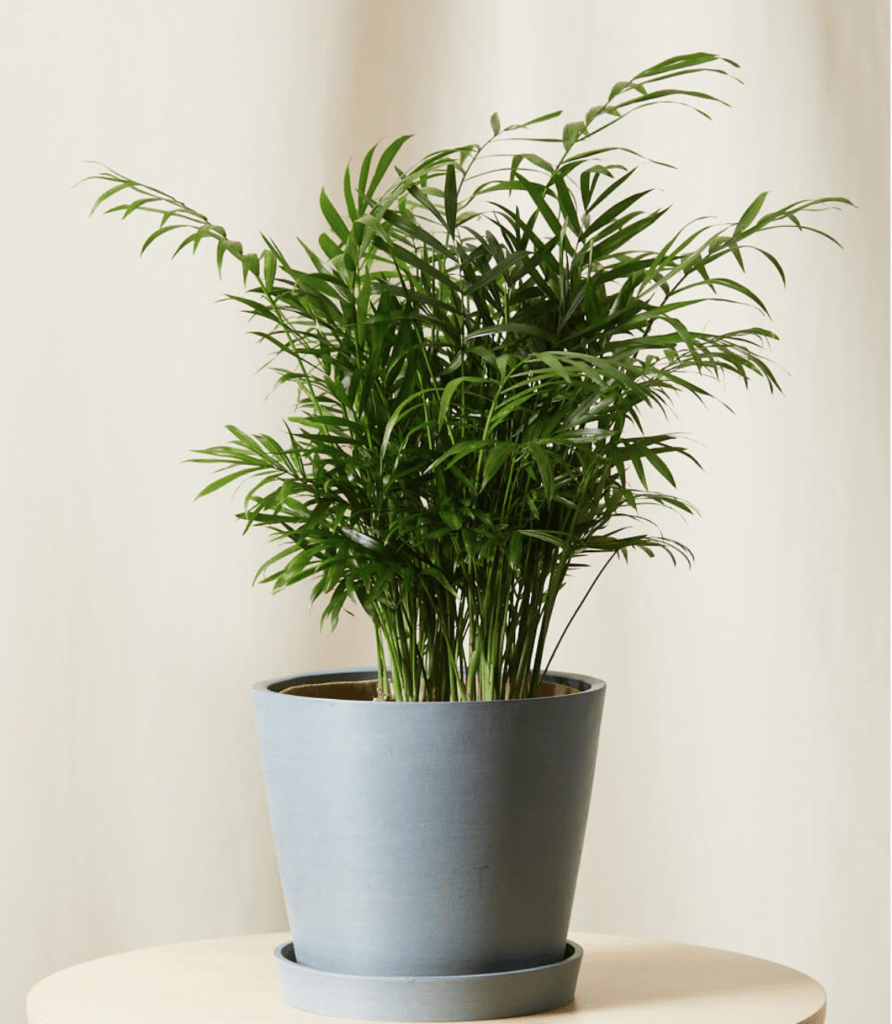
($35)
$28
“For over five years, this plant has been such a resilient and forgiving addition to my living room” – TheSill customer
15.Olive Tree
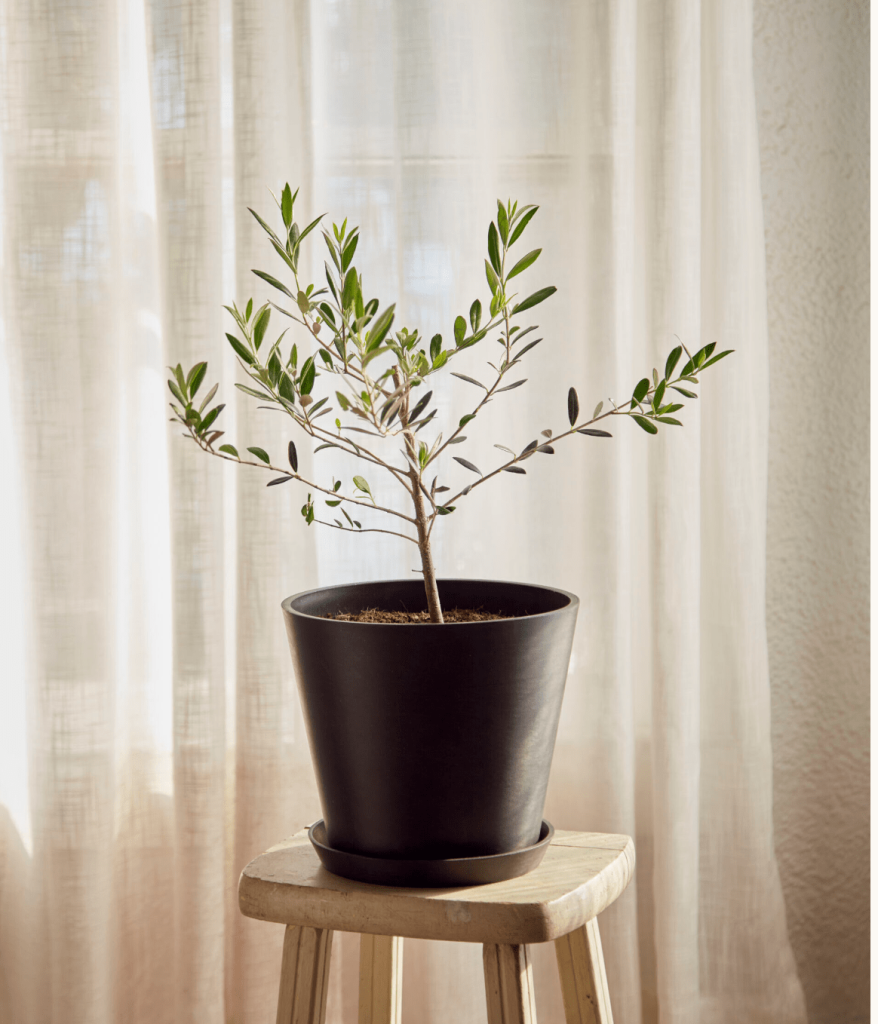
Pet safe
Bright light
Grows 6-10 feet
South facing windows
Pet safe
Bright light
grows to 6 feet
South facing windows
The Olive Tree (aka Olea europaea) is a member of the Oleaceae family. We’ve positioned ours in the south-facing living room. This tree has slender, silver-green leaves and is celebrated especially for the gnarled beauty of its trunk as it matures, often becoming a focal point of the room.
The Olive Tree requires minimal watering and can grow up to 6-10 feet indoors, though it grows much taller in its natural habitat. It’s not toxic to cats and dogs! To complement its Mediterranean charm, we’ve opted for a simple ceramic planter that accentuates its rustic appeal!
Care tip:
- Place it in a location with full sunlight—this plant loves at least six hours of direct sun daily.
- Water it sparingly. Allow the top inch of soil to dry out between waterings.
- Olive trees are drought-tolerant once established. But keep an eye out for leaf drop or wrinkling which indicates stress from too much or too little water.
Propagation tip:
- Select a healthy 8-inch semi-hardwood segment from an olive branch.
- Strip the lower half of the cutting of leaves, dip the cut end into rooting hormone, and place it in water.
- Change the water regularly and expect roots to begin forming within a few weeks
Symbolism and zodiac signs:
- Symbolizes peace, wisdom, and strength across various cultures and traditions. It’s deeply revered for its endurance and capacity to thrive in harsh conditions, most apt for virgos!
Pros and cons
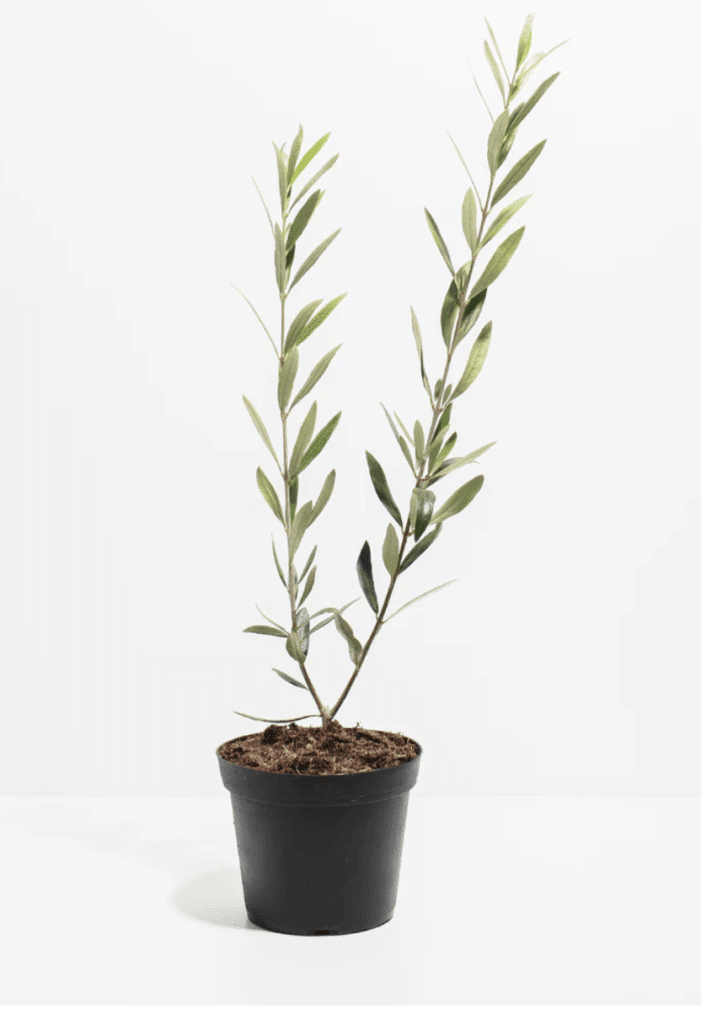
($58)
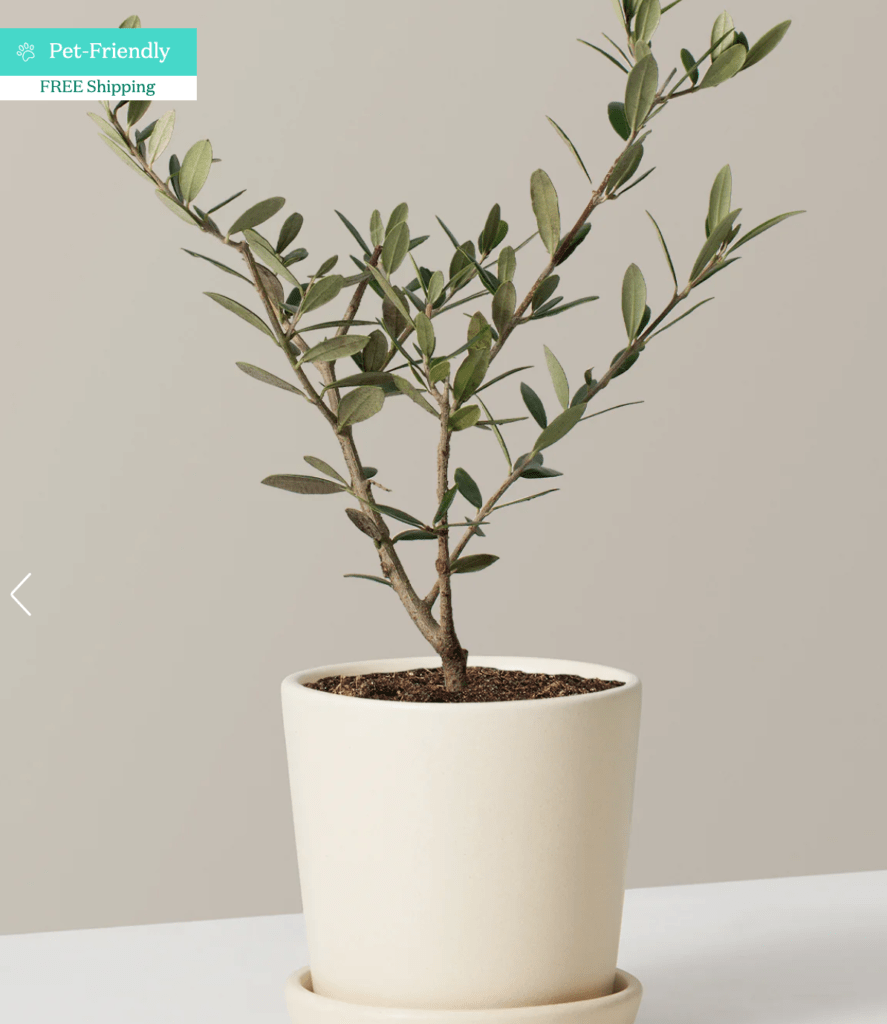
($38)

($91)
$28
“I am so happy with this olive tree. It is the perfect size to start and watch it grow. I love the colors of the leaves, a different shade from my other plants. The price is great for an olive tree. It’s great as a gift as well.” – Amazon customer
Other Cat safe indoor plants:
- Alocasia jacklyn
- Alocasia hilo beauty
- Alocasia pink dragon
- Dracaena Reflexa
- White Christmas cactus
- Hoya rope plant
24. Birds Nest Fern

Pet Safety: Non-Toxic
Size: 2.0 ft
Window: East / West
Care tip: Water around the center, not into it—avoiding the rosette when watering prevents crown rot in this fern.
25.Lady Palm

Pet Safety: Safe
Size: 6 ft
Window: East / North
Care tip: xtremely adaptable to low light and indoor air—an easy, pet-safe palm that tolerates dry air and shady corners with ease.
26. Pineapple plant
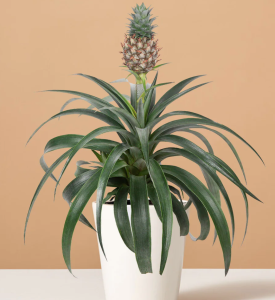
Pet Safety: Safe
Size: 4 ft
Window: East / South (Bright light)
Care tip: This bromeliad loves sun – give it the brightest spot you have so it can potentially produce its little pineapple fruit. If your humidity is low, you can pour a bit of water into its leaf cup (center “tank”) – just refresh that water every week or so to prevent stagnation. After fruiting, the mother plant will slowly die back, but don’t worry — it usually produces baby pups around its base that you can pot up for a brand new pineapple plant.
27. Burros Tail
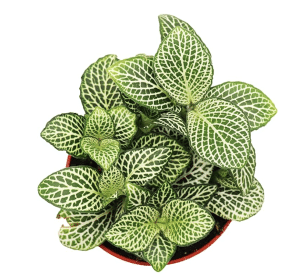
Pet Safety: Safe
Size: 2 ft
Window: East / South (Bright light)
Care tip: Handle this plant with care – its plump little leaves fall off at the lightest touch! (Tip: if some do drop, lay them on top of soil – many will sprout new babies). It craves sunshine, so give it a bright spot. Water sparingly. Overwatering will cause those fat leaves to rot or drop. If stems start looking bare or stretched, it may be craving more light
28. African Violet
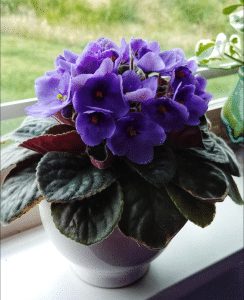
Pet Safety: Safe
Size: 2 ft
Window: East / West
Care tip: Avoid splashing water on its fuzzy leaves—bottom-watering or watering with room-temperature water keeps those leaves spot-free.
29. Areca Palm

Pet Safety: safe
Size: 6 ft
Window: East / South
Care tip: Remove any brown fronds as they appear and provide bright light—this elegant palm is low-maintenance, but appreciates the occasional grooming to look its best.
30. Echeveria
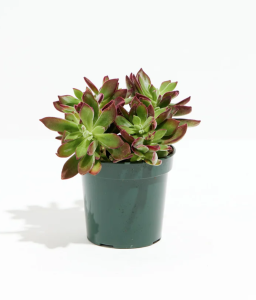
Pet Safety: Safe
Size: 1 ft
Window: East / south (Bright direct light)
Care tip: Sun-loving and low-water – a true desert type. Give it the brightest light you can. Plant in very well-draining soil and water only when the soil is bone dry. It’s better to underwater than overwater an Echeveria (soggy soil will quickly lead to rot). Gently pull away any dead, dried leaves at the bottom of the rosette occasionally to keep things clean! Prevents fungus!
31. Wax Plant
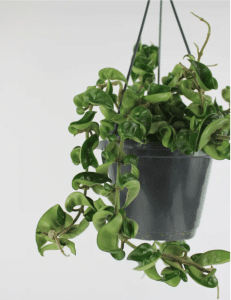
Pet Safety: Non-Toxic
Size: 6 ft
Window: East / South
Care tip: Don’t cut off the old flower spurs – your Hoya will often rebloom from those same little stubs. It also likes to dry out between waterings, so avoid overwatering.
32. Money Tree
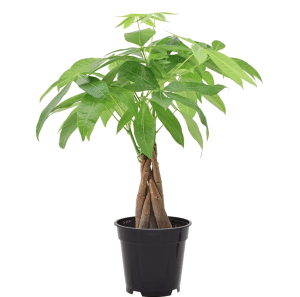
Pet Safety: Non-Toxic
Size: 6 ft
Window: East / South
Care tip: Avoid cold drafts—sudden chills can cause leaf drop. This resilient tree likes a consistent spot; turn it every so often for even growth, but otherwise let it enjoy stability.
33. Moth Orchid

Pet Safety: Non-Toxic
Size: 1.5 ft
Window: East / West
Care tip: After blooming, trim the flower spike above a node to encourage a possible rebloom. Orchids prefer bright, indirect light and consistent moisture – but never let them sit in water.
34. Ponytail Palm

Pet Safety: Non-Toxic
Size: 3.5 ft
Window: West / South
Care tip: Incredibly drought-tolerant – its bulbous base stores water. When in doubt, skip watering (it truly needs water only about once a month). Give it plenty of sun for optimal growth.
35. Purple Calathea

Pet Safety: Non-Toxic
Size: 1.5 ft
Window: East / north
Care tip: Calatheas love soft water – use filtered water to avoid leaf burn from minerals. They thrive in humidity, so consider placing them in a humid area (like a bathroom) or misting regularly for vibrant foliage.
36. Purple Waffle Plant

Pet Safety: Non-Toxic
Size: 1 ft
Window: East / West
Care tip: Keep soil consistently moist – this little plant wilts quickly when dry, but perks right back up after watering. Pinch off any leggy stems to encourage bushier growth.
37. Rabbit Foot Fern
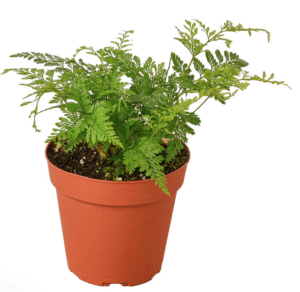
Pet Safety: Non-Toxic
Size: 1.5 ft
Window: East / North
Care tip: Those fuzzy “rabbit’s feet” rhizomes on the soil surface aren’t just for show – keep them slightly moist by misting to help this fern thrive. It enjoys humidity and gentle, even moisture (never let it dry out completely).
38. Stromanthe Triostar
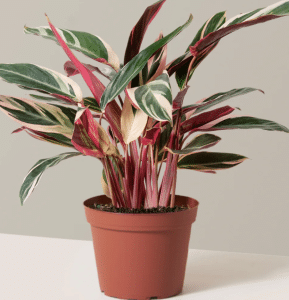
Pet Safety: Non-Toxic
Size: 2 ft
Window: East / North
Care tip: Show off its pink-streaked leaves in bright, indirect light – lower light may cause the colors to fade. It appreciates high humidity like its Calathea cousins (mist it to keep those tri-color leaves vibrant).
39. Goldfish Plant
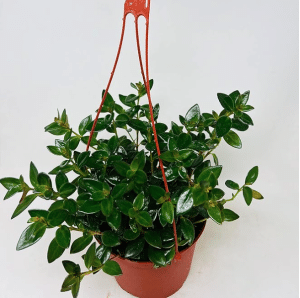
Pet Safety: Safe
Size: 2 ft
Window: East / South
Care tip: More light means more “goldfish” blooms – give it bright light (avoiding harsh midday sun) to keep those orange flowers coming. Keep soil evenly moist for continuous flowering.
40. Purple Passion
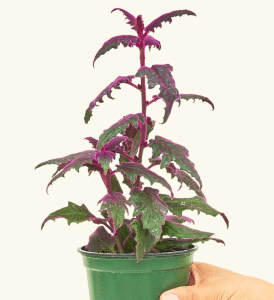
Pet Safety: Safe
Size: 2 ft
Window: East / West
Care tip: Pinch off the tips regularly to keep it bushy and delay flowering (once this plant blooms, it’s nearing the end of its lifespan). This encourages a fuller, more vibrant purple display.
41. Maranta Red Prayer

Pet Safety: Non-Toxic
Size: 1 ft
Window: East / north
Care tip: Its red-veined leaves fold up each night like praying hands—totally normal! Keep soil lightly moist and provide humidity to prevent leaf curl.
42. friendship Plant
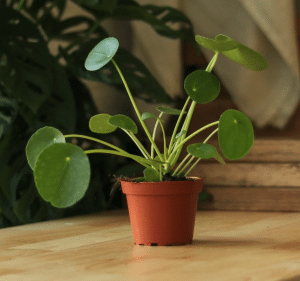
Pet Safety: Non-Toxic
Size: 1 ft
Window: East / north (Medium light)
Care tip: Thrives in terrariums due to its love of humidity. Pinch back leggy stems to keep it compact and bushy.
43. Venus Flytrap

Pet Safety: Non-Toxic
Size: 1 ft
Window: West / South (Bright light)
Care tip: Use only distilled or rainwater for this carnivore – minerals from tap water can harm it. It also benefits from a cool winter dormancy period.
44. Calathea Medallion
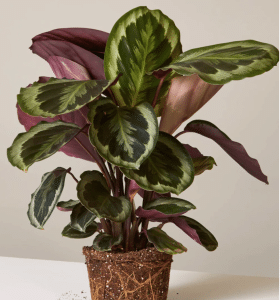
Pet Safety: Non-Toxic
Size: 1.5 ft
Window: West / North (Medium light)
Care tip: Keep it out of direct sun to maintain its vivid patterns. Likes evenly moist soil – water when the top layer starts to dry, but don’t let it sit in water.
Pet Safety: Non-Toxic
Size: 1.5 ft
Window: West / East (Medium/Bright light)
Care tip: Prefers cooler indoor temps (around 60°F) and bright shade. Water when the soil surface starts to dry – and watch for new plantlets on its runners!
46. Wax begonia

Pet Safety: Non-Toxic
Size: 1.5 ft
Window: West / East (Medium/Bright light)
Care tip: Tolerates both sun and shade, but bright indirect light yields the best blooms. Remove spent flowers to encourage continuous blooming, and let the topsoil dry slightly between waterings.
47. LipStick plant
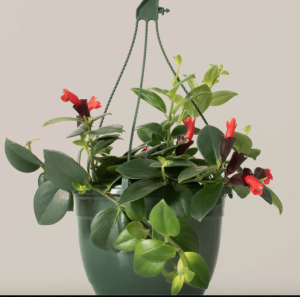
Pet Safety: Non-Toxic
Size: 2.5 ft
Window: South / East (Medium/Bright light)
Care tip: More light means more blooms – if it’s not flowering, move it closer to a bright window. Water when the top inch of soil is dry, and avoid letting it sit in water.
48. Golden Mosaic plant
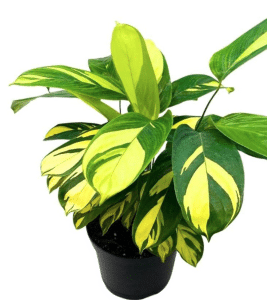
Pet Safety: Non-Toxic
Size: 2.5 ft
Window: North / East (Medium/Bright light)
Care tip: Give this variety plenty of bright, indirect light to keep its yellow-veined foliage vibrant. Like other Fittonias, it enjoys high humidity and consistently moist soil.
49. Zebra plant
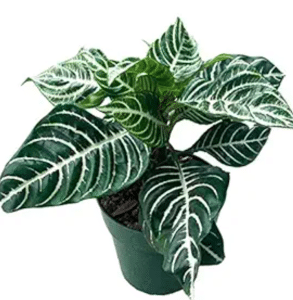
Pet Safety: Non-Toxic
Size: 1.5 ft
Window: West / East (Bright light)
Care tip: Craves humidity – mist it regularly or use a pebble tray to keep humidity high. Keep soil evenly moist (not soggy) and provide bright light to encourage its yellow blooms.
50. Watermelon Peperomia

Pet Safety: Non-Toxic
Size: 1.5 ft
Window: West / East (Bright light)
Care tip: Avoid direct sun, which can scorch its patterned leaves. Water when the top soil dries; its thick leaves store some water, so it doesn’t mind brief dryness.
How to choose indoor plants that are not toxic to cats and dogs?
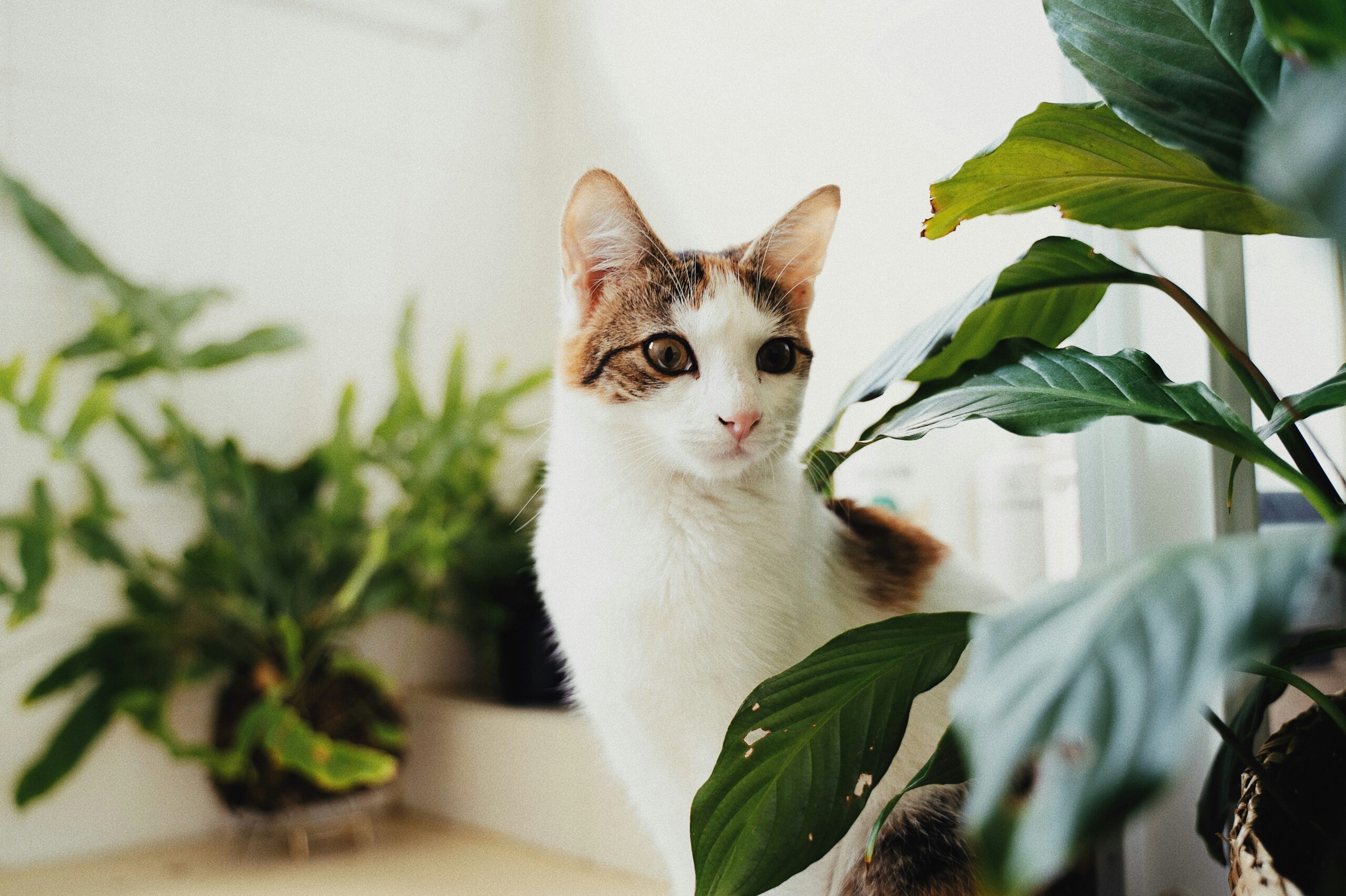
Here are the top 5 things to consider:
Prioritize Texture Over Color:
Pets – especially cats and dogs – may be less inclined to chew on plants with rough or spiky textures. Our cat hates fiddle leaf figs and rubber plants. Opt for plants like Cast Iron Plants or Ponytail Palms, which are not only safe but less appealing for pets to nibble on. On the other hand, plants like pothos are very alluring for cats to nibble on and can be dangerous if consumed.
Understand Your Pets’ Behaviors:
Observe whether your pets have a tendency to chew or dig in your houseplants. And then choose plants accordingly. If your pet is particularly into munching on the plants, you should stay away from plants that are mildly toxic as well, as chewing even mildly toxic plants can cause digestive and kidney issues. But if they are not into munching, then perhaps staying away from extremely toxic plants like lilies, and mounting the others that are mildly toxic or hanging them would be find.
Verify Plant Care Needs
Ensure the plants you choose do not require the use of harmful chemicals for their maintenance. Plants like Spider Plants and African Violets are not only non-toxic but also thrive without the need for strong pesticides or fertilizers. In general, the plants we buy and recommend do not require chemicals and in our house we don’t bring them at all. But if you are inclined to using chemicals on the plants especially when there is a pest infestation, keep them out of their reach for a while and then wash them and bring them in.
Seek Out Low Allergen Plants
When choosing low-allergen plants, consider: Areca Palm and Bamboo Palm that produce minimal pollen. Spider Plants are also excellent for pets as they don’t release airborne irritants. Regularly wipe plant leaves to minimize dust and potential allergens which also enhances the ability for the plants to purify air. Opt for plants that grow in low light to further reduce the risk of allergies exacerbated by direct sunlight – we have a whole list of low light plants for you in a different article.
Always Check the ASPCA Database
Finally, before making any plant purchase, reference the ASPCA’s extensive list of toxic and non-toxic plants. It is absolutely essential to verify any information you see online with respect to pet safety with these sources because one misinformation may lead you to that anxiety filled trip to the vet, which we don’t want 🙂
How to Create a Pet-Friendly Indoor Garden
Here are the top 5 things to consider:
Secure Planters and Pots
Ensure all planters and pots are stable and secure to prevent them from being knocked over – bad for the pets if they fall on them, but also to the plants whose stems might break. Heavier pots can be a good choice, or may be even mounting some plants on walls or high shelves could work. Hanging plants are also excellent option.
Avoid Small, Chewable Decorations:
Small stones, decorative marbles, or beads can be hazardous if ingested – we don’t have any of them in our home in brooklyn. We do have large disco balls, however, to refelct light, but they are large and are pet safe. Basically if you have to decorate, choose the ones that are not easy to swallow.
Incorporate Pet-Safe Fertilizers:
When it comes to maintaining your plants, use organic or pet-safe fertilizers. Avoid products containing chemicals. Definitely stay away from peat based soil and fertilizers. They can inadvertently cause harm to your pets, even if the plants you have brought aren’t toxic. We only use organic soil, neem oil and other mixtures to treat plant issues.
Designate a Plant-Free Zone
Despite all precautions some pets may still be tempted to explore. Consider setting up a specific area where your pets can play freely without the temptation of nibbling on your greenery . But also set up an area where cats and dog are perhaps not free to explore if you are so tempted, as we were, in bringing plants that may cause harm to pets. Our top floor is completely closed off to our cats, and that is where we have plants that are not entirely safe for them, but we can live without anxiety because cats never go there.
Create a Pet Deterrent Plan:
If all things fail: consider natural deterrents. Citrus peels, cayenne pepper, or a spray made from diluted vinegar can keep pets away from plants. These methods are harmless but will make the plants less appealing to pets.We have also heard velvet deters dats, so some velvet textured materials to use around the plants stems and soil may work as well. Above all, if the cats and dogs are well fed, they are less likely to nibble on anything that is not their food 🙂
How to Prevent Pets from Damaging Your Plants
Here are the top things to consider:
Spray Plants with Pet-Safe Bitter Apple
Many pets dislike the taste of bitter apple – directly on the leaves of plants. This non-toxic deterrent can make plants unappealing to chew without damaging the plant or risking your pet’s health.
Create Barriers
Physical barriers can be effective in keeping pets away from your plants – decorative fences, pet gates, or even a strategically placed piece of furniture can block access to areas with a lot of plants. Our cats love nibbling on our ponytail palm, so we have a placed it on a shelf, and there is no nearby furniture for them to jump on, in order to nibble on the leaves.
Choose Strategic Plant Locations:
Elevate plants to heights that are out of reach for your pets: Hanging planters, high shelves, or tall plant stands can keep them safe, but also consider crowding your shelves with other things so the pets, especially cats have no space to jump onto the shelf and then try to eat. This is one of the ways in which we keep our flowering orchids safe from cats because they love to nibble on the colorful flowers and we would hate to see them gone 🙂 (Refer our list of trailing houseplants for more info)
Incorporate Distraction Techniques
Instead of focusing only on keeping pets away from plants, provide them with ample toys and alternative activities. A well-entertained pet is less likely to seek out plants as a source of amusement or chewing. And like we said before, feed them well every day and train them by maintaining the feeding schedule so they don’t nibble on plants.
FAQ
What are some popular indoor plants that are safe for pets?
- Spider Plant, Areca Palm, Boston Fern, and Peperomia. These plants are widely recognized for being non-toxic to both cats and dogs and are relatively easy to care for.
How can I ensure a plant is non-toxic to my pets?
- Cross-reference any new plant with the ASPCA’s list of toxic and non-toxic plants. Some plants are toxic meaning, even a physical touch can cause toxcicty in cats and dogs, and some are toxic only if they eat the leaves in large quantities. For example lilies are highly toxic, while pothos and zz plants are toxic if consumed in high quantities by the cats.
Are there any low-maintenance, pet-safe plants suitable for beginners?
- Some great easy care plants include the Spider Plant, areca palm, boston fern, ponytail palm, hoya varieties
How should I position my pet-safe plants to keep them out of reach?
- Use hanging planters, high shelves, or tall plant stands to keep plants out of your pets’ reach. Create physical barriers. And also crowd the plants so cats can’t jump to the shelves they are in, and then eat.
What natural deterrents can I use to keep my pets away from plants?
- Natural deterrents like citrus peels, cayenne pepper, or sprays made from diluted vinegar can help keep pets away from your plants. They do not harm the plants when sprayed.
Note on how we compiled this list
This list wasn’t just pulled together—we grew it, lived with it, and double-checked it. We spoke to fellow community gardeners, including one of our own housemates, and drew from our experience caring for hundreds of houseplants in our Brooklyn community home. We also verified plant details with authoritative sources like The Spruce, Better Homes & Gardens, The Sill, ASPCA, and Garden Design to make sure every recommendation is trustworthy, accurate, and helpfu!

